Part 2 of 3
India, Nepal to Tibet, and Kashmir Trip
April 17 to May 8 (22 Days) in 2009
This is part of my journal for the vacation that I booked with Himalayan International Tours http://www.himalayantours.com/
126 Madison Avenue, 2nd Floor , New York, New York 10016, Phone: (212) 564-5164 , (800) 421-8975
Map of India, Nepal to Tibet, and Kashmir Trip. This was really three separate trips:
Part 1: Day 1 to Day 6: Delhi to Jaipur to Agra
Part 2: Day
7 to Day 16: Kathmandu, 5-day Drive to Lhasa Tibet, Lhasa
Part 3: Day 17 to Day 22: Kashmir and then home
If you see anything that doesn't look correct, or you have something to add, please let me know.
Table of Contents
Thursday April 23 - Day 7 - Drive AGRA to DELHI 125 miles (202 km). Fly to KATHMANDUFriday April 24 - Day 8 In KATHMANDU - PATAN
Saturday April 25 - Day 9 - (Drive Day 1) KATHMANDU to NYALAM (3750 m or 12,300 feet)- 96 miles (156 km)Sunday April 26 - Day 10 - (Drive Day 2) NYALAM to TINGRI LHATSE 140/150 miles (225/244 km)Monday April 27 - Day 11 - (Drive Day 3) TINGRI / LHATSE to XIGATSE 150 miles (244 km)Tuesday April 28 - Day 12 - (Drive Day 4) XIGATSE to GYANTSE 55 miles (90 km)Wednesday April 29 - Day 13 - (Drive Day 5) GYANTSE to LHASA 162 miles (261 km)Thursday April 30 - Day 14 - In LHASAFriday May 1 - Day 15 - In LHASASaturday May 2 - Day 16 - Fly LHASA to KATHMANDU to DELHIEtc
Thursday April 23 - Day 7 - Drive AGRA to DELHI 125 miles (202 km). Fly to KATHMANDUThis is what the itinerary said:
23 April Agra - Delhi Drive 202 km- Kathmanu, Fly Air India
Drive back to Delhi. On arrival, transfer to International Airport for Kathmandu flight. Arrive Kathmandu by Air India. Flower garlands receptions at the airport and transfer to hotel Annapurna. PM: Free for orientation.
This is my account of the day:
Depart from Agra at 5:30 am. So I had a 4:30 am wake up call. Ouch. Actually, it was not difficult to get up since I went to bed so early.
So it is day 7 on my adventure and I'm still healthy, so far. Thank God. For real. I can feel him with me. I could not do this without him. So I'm not totally alone. I am truly enjoying the solitude when I get it. When I'm with a guide, he has my full attention, but I know I can rest and recover later. I'm really looking forward to Kathmandu.
It's so early that the road a void of traffic. Irshad goes through the intersections even with a red light. Apparently you only to obey traffic lights during the day? When there is no traffic, you can go through a red light, but I think he stopped at a light at 6:30 am.
At 7:10 we stopped for breakfast. I see cheese on the menu! I was wondering if this country had any cheese. I ordered a cheese omelet, a can of orange juice, English tea.
The places that we stop are no stress shopping also. I like that. There is lots to choose from and nothing that I need or want. But no one is forcing things in face to look at. For 40 Rs I got a very small stone set in black marble marble mother of pearl maybe. Taj Mahal souvenir. That's it. The only purchase of this trip so far.
10 am and we are in Delhi. Driving in this city is crazy. Cars "float" all over the road. You do not stay in the marked lanes. You can just push bicycles or trucks over to get through. If you drove that that in Atlanta you would get arrested for drunk driving.
On the back of the tuk tuk was painted "We Two" "Our Two" means a small family with 2 kids. Irshad saw another one that said "We Two" "Our 10". That is big family.
A commercial license that last for 20 years costs 3000 Rs.
We are getting near to the airport so traffic is a lot more congested. The air conditioning was getting warm so we opened the windows of the car. Now that's a whole new experience. To feel the heat and hear the noise, it feels like we are really in the traffic . With AC it is quieter - you don't get that experience.
.JPG)
10:50 am - Irshad dropped me off at the Indira Gandhi International Airport terminal in Delhi.
He was a fabulous driver, good conversationalist, and knew exactly when I needed to stop for something. He was very courteous, asked permission to turn on the radio, open the window etc. And he was always on time, I mean, he was always early. He really made my visit to India a pleasure.
Thanks Irshad!
I'm on Indian Airlines flight 813 that leaves at 1:40 pm.
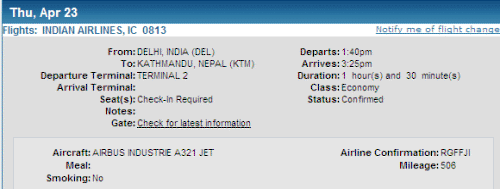
Check-in for my flight is not open yet so I sit at the gate and wait. I met the most amazing person:
Keshav Raj Maharjan Google Mapmaker, IT Engineer
He said that any information that I could collect for Goggle Maps would help. Oh boy, now I've got an assignment to track the road for Google. I'm going t o run out of paper. But if it makes this trip easier for anyone else, then I have to seize that opportunity.
He said to go to www.openstreetmap.org. It is user-contributed, free downloadable maps, to GPS also.
Keshav said that Doodle's Bar - Thamel is probably the place where Sir Edmund Hillary visited and where Dad had a drink when he was here in Kathmandu.
He said a postcard should only cost 10Rs, Magnet for 50Rs
11:15 and we are still waiting for the Kathmandu airplane. There is a "delay announcement" on the loudspeaker and they say my flight. We are supposed to take off at 1:40, now 2:15. Fine. Whatever. Time to write.
I do not like this Delhi International Terminal. No sign or notices or indications when you are at a gate where the flight is going . No information is displayed at the gate. Everything is announced and you better not miss the gate change announcement. So I'm at gate 2 with Keshav. I go the toilet, come out and there is lots of commotion at Gate 1. It's my flight leaving. I did not see Keshav. They searched our bags, and sent me behind a screen to get patted down. Get on a bus, ride to the plane, get on. Finally I see Keshav get on the plane.
2:15 and I just boarded the airplane to Kathmandu. Talking to Keshav was a god-send. The gate changes so I was sitting at the wrong gate and he came to get me to go to the other gate. Very interesting about google map making. OK, I should shoud have brought my GPS. I have a difficult enough time keeping up with my phone and camera and chargers. I feel better that there are plenty of Western looking people on this flight. 1 hour and 30 min. Here's hoping the Mr. Hari is waiting for me. How crazy is this trip. Yup, nuts. See this through, and live to tell about it. And I'm also having a great time! I'm feeling generally calm and a little anxious. New experience coming up.
The airline served a nice meal. I got veg (instead of the chicken). The spice was just right so I ate it all. We got the smallest water bottle that I have ever seen. Took some great pictures of the snow-capped mountain tops peeking over the top of the clouds. How cool is this:
.JPG)
Looking out of the airplane window as we are landing in Kathmandu, I see terraced plots within hills. The buildings are not too dense. All very quaint looking. We are surrounded by mountains everywhere! Whosh. Very hard landing. 31 degrees C now.
b.JPG)
Ok, Part 1 of this 3-part trip is over, and Part 2 is beginning. Part 1 (Delhi, Jaipur, Agra) was for posterity to repeat what my Grampa saw. Parts 2 (Nepal/Tibet) and 3 (Kashmir) are for me to have another adventure. Because I don't want to go home.
The sign says "Welcome to Nepal. The birthplace of Lord Buddha". Hmmm, why is that lady behind me in the picture wearing a mask?? Could it be pollution? Could it be Swine Flu? That's all part of joys of traveling.
First thing you see in the Arrival Hall in the Nepal, Kathmandu airport is tables where you fill out Visa forms. Keshav directed me to the last table with the English forms. They ask all the traditional questions.
Application for diplomatic/official/tourist visa questions:
Name, Nationality, Place of birth, date of birth, permanent address, temporary address in Nepak, occupation, passport no, date of expiry, objective of journey, intended length of stay, arrival date, flight number, means of support in Nepal (state amount in foreign currency), particulars of previous visit (if any).
You must have a picture, or was that 2 pictures? I heard them tell a girl that they could take the photo for $14 USD. They only take US dollars (no Euros, no Rupees) and the cost of the Nepal Visa is:
Transit Visa for 1 day is $5 USD
Tourist Visa for 15 days is $25, for 30 days is $40, for 90 days is
$100 USD.JPG) Keshav was very nice to wait while I got my visa and put the arrival stamp in my passport. Next, (before you exit) is a room where you can change money. I instinctively (is that a word?) got to the local banks. I've been ripped off with commissions at Thomas Cook and Cambio's in enough countries and they all give you local currency. I had this information with me for Nepalese Rupee Npr exchange rates:
Keshav was very nice to wait while I got my visa and put the arrival stamp in my passport. Next, (before you exit) is a room where you can change money. I instinctively (is that a word?) got to the local banks. I've been ripped off with commissions at Thomas Cook and Cambio's in enough countries and they all give you local currency. I had this information with me for Nepalese Rupee Npr exchange rates:
1 Eu = 108.21 npr 20 Eu = 2164 npr 50 Eu = 5410 npr | $1 = 82.03 npr $10 = 820 npr $20 = 1640 npr $50 = 4100 npr $100 = 8200 npr | 1 npr = $ 0.0122 10 npr = $0.12 20 npr = $ 0.25 100 npr = $1.25 200 npr = $2.50 400 npr = $5.03 1000 npr = $12.58 |
The rate for USD was 77 for cash and 78 for Travelers Checks (that does not include the commission). I had a (2-week old) rate of 82, so 77 didn't seem that bad. The rate to exchange Euros was 102 minus the commission so it was 97.5. So I convert Euros because I have them and I don't know when or if I will go back to Europe. You certainly don't need Euros in Tur
key. So 50 Euros x 97.5 is 4875 Nepalese Rupees, which is about $65 USD that I'll need for food, tips, postcards, and maybe a souvenir.FYI - When I got to the hotel, their posted exchange rate for Nep Rs:
USD 76.95 Cash, or 77
.65 Travelers Check.Euro 99.63 Cash, or 100.66 Tr
avelers check.99.63x50 = 4981 - 4875 , 106 difference. not much of a difference.
After changing money, we walked ten steps and I see my name being held up on a sign. Yeah, they are here to pick me up! I have been so impressed with the communication and arrangements of everything by this tour company so far. They call ahead and confirm, make sure I'm happy.
So we exit the airport and I am greeted by Suresh.
Suresh Nakarmi
.JPG) Executive Director, Shakti Travels & Tours (P) Ltd, Shaki Treks & Expedition Pvt. Ltd. http://www.shaktitravel.com/
Executive Director, Shakti Travels & Tours (P) Ltd, Shaki Treks & Expedition Pvt. Ltd. http://www.shaktitravel.com/
PO Box 913 La
zimpat Kathmandu Nepal Tel: 977-1-4428552, 4428691 Mobile: 9851026424
Email: shakti@travels.wlink.com.np and info@shaktitravel.com
Mr. Hari Nakarami was my driver.
He gave me a flower garland. I introduced them to Keshav and we gave him a ride out of the airport. Here's a photo of Keshav. He was such a great friend to have at the airport. I will definitely be contact with him to provide Google Map info!
I can't believe I'm here in Kathmandu and I'm still healthy, thank God. This is why went on this trip in April: the temperature and rainfall is ideal for India, Nepal, and Tibet in April.
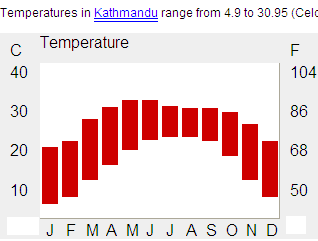
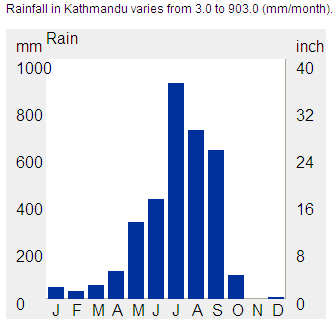
Kathmandu Weather - There are four main types of weather in Kathmandu: hot and muggy, hot and rainy, balmy and clear and just plain chilly. In the shoulder seasons of October-November and March-April views are clear, temperatures are warm without being oppressive and rain showers are brief and refreshing. November to February is also clear and dry but often cold, especially after dark. May and June can be unbearably hot and muggy until the monsoon arrives to inundate the country with unrelenting rain from June to September.
Suresh checked me into Hotel Annapurna
http://www.annapurna-hotel.com/Hotel de l' Annapurna, PO Box 140, Durbar Marg, Kathmandu, Nepal
Telephone: (00977) 1 4221711
Established in 1965, Hotel de l Annapurna prides in being the first Five Star Hotel of Nepal.
Rooms have international direct dial facility, wireless Internet connectivity, mini bar, personal safe, and colour television with satellite programmes, safe deposit boxes and views that overlook the pool. Air Conditioning , Bathroom Amenities , Coffee Maker , Hairdryer , Wi-Fi Internet , Ironing Board , Refrigerator Luxurious and upgraded furnishings , Separate seating area , Newspaper & Magazines , Telephone - Auto Wakeup , Telephone - with Dataport , Thermostat (adjustable) , 60 Channel TV
Here's a photo of the hotel and the lobby in the hotel:
.JPG)
.JPG)
In the lobby of the hotel, the clock on the wall shows that if it is 5:54 pm here, then it is 7 am in New York.
I gave my passport and three pictures to Suresh so he could get my China visa. I have 2 nights here in this hotel in Kathmandu. Then he explained that I will join a group for the drive to Lhasa, Tibet. Nights 1 and 2 I paid for a single room, but nights 2 and 3 maybe share. That's fine. Lhasa room is a single with "attached toilet to room".
Suresh asked me what time I wanted to start the tour tomorrow: 9 or 9:30. Well, we settled on 10 am. I am loving this. I get to say when to start, well I am traveling as a single so that is a wonderful luxury that comes with it. I could really get used to this, but I'm not sure that I really want to. Anyway. That's a whole 'nother issue.
I got up to my room and started unpacking. I turned on my cell phone and I got a signal! I tried calling dad about 20 times, but every call failed because the circuits were busy. I'll try an email later.
This is really too cool. I am totally loving this whole experience. I imagined me and a driver for 5 days to Lhasa but thank goodness I'll be with a group.
I am so tired. I could venture out, but I'm not going to push myself on this trip. I want to take every opportunity to relax that I can. So I need to go find some water to buy, send a email.
I finally got through to Dad on the phone. We had a brief chat. Every thing is fine! Awesome trip.
So I found my camera turned on in bag. I need to keep it in the hard case so buttons don't get accidentally pushed. Oops.
I sure am glad I brought all the converter plugs. I'm using a different one in Nepal to charge that camera battery.
Suresh called me to meet him in the lobby at 6 pm. We had to fill out long form for the visa application. They did not have this form last year. This was new. China requested all the traditional information, and some awkward questions also. They asked have you ever been to China before, if you had ever been denied a China visa. You had to put a contact place and phone number in China. He had to call the tour company for that information. For occupation, he recommended that I do not write "Technical Writer" because China doesnt care for journalists (writers). So we put "computer technician". I had to put the company name, address, day and night phone number. There were medical questions, do you have HIV Positive or AIDS, Mental diseases, other infectious diseases? Etc. Have you ever been refused a visa for China, have you ever been deported from China, do you have a criminal record in China or any other country.
Very thorough. The additional $198 USD that I paid Himalayan Tours before I left on this trip covered the cost of the visa application and to expedite and obtain the approved Arrival and Exit visa papers in one day. He took my application and said I would get my passport back the next day. OK.
8 pm I went to the coffee shop for a little dinner. Spaghetti Napolitain - I hope that is tomato sauce.
Cost was 1 Spaghetti 375 (about $4 USD).
3 bottles of water for 270 Rs (about $3 USD)
Sub Total 645 + 64.50 Service Charge + 92.24 VAT = 802 total.
Whew, I am so tired. At least I only ordered one thing off the menu tonight. I am getting the crick in neck again now. Sleep on a big pillow tonight. I forgot write down cost for a liter of water is usually about $1 USD, but sometimes $0.50.
I found some souvenir t-shirts also. Green and orange colors and they say "Top of the World" $5 USD each. They also had some leather bags, but I wish it was a little bigger. Postcards were 10 Rs each.
10 am depart tomorrow. Wake up call at 8 am.
Back to Top
Friday April 24 - Day 8 In KATHMANDU - PATAN
This is what the itinerary said:
24 April Kathmandu Patan
Sightseeing tour of Kathmandu City once called "Kantipur" or "City of Glory" visiting Kasthamandap, Temple of the Living Goddess called "Kuman" or "Kumarni" Hanuman Dhoka, Kal Bhairab - God of Terror. Taleju Temple of "Swayambunath" or The Monkey Temple. This Buddihist stupa is majestically set high upon a hill over looking the Kathmandu valley.
Lunch on your own and can had at one of the many good standard restaurants around town. Our guide will recommend the same.
After lunch we visit Patan city, one of the three queen cities the other two being Kathmandu city and Bhaktapur. Patan city is the city of fine arts and we visit Durbar square, Krishna Mandir, Mahavihar-Golden Temple of Lord Buddha, built in the 12th century. We also visit the Tibetan Center. Page 793. Map 777.
Breakfast at the hotel is from 7 to 10 am. I made it around 8:30. It was a very big beautiful buffet with everything that you could want. There is even a omelet station. I had a big bowl of thick porridge. Yum - very good. Also some green beans and grilled tomatoes.
I slept great last night. Slept deep. I had a great night sleep because I've realized that there is a lot less to worry about than I've been imagining. That revelation makes the trip a lot nicer when I don't stay awake worrying like I did in Delhi. It is a very very hard bed with big pillows that squish down . I need to stretch my neck is so stiff. Think I went to sleep around 8 pm and I finally got out of bed at 7am. Oh yeah. That's what I'm talking about. THAT IS A VACATION!
I took a malaria pill this am.
9:30, no make that 10 am departure from the hotel. Hari Nakarmi was there at 9:45 and I was waiting in the lobby. Surendra, my personal Kathmandu city tour guide was also there.
At the end of the street where the hotel was located was a Pink building. It was a Palace where the king lived, but it is now a museum. Narayanhiti.
We turned left and drove by a very tall walled complex, the "America Club". I don't think it was the Embassy, just a protected place where American can relax maybe?
Interesting information from Surendra (I love it that he started our tour with political information).
216 square miles and population of 1.5 million in 2001 maybe. Population of Kathmandu is 3.2 million. Population of Nepal 25.9 million.
Religion:
Budd
hist 20% Christian 1.5 % Muslim 3% Hindu 70%But officially, this is the breakdown
Budd
hist 7.5% Christian 1 % Muslim 25% Hindu 85%There are 75 ethnic groups in Kathmandu.
There are 601 in the government assembly. The old constitution was scrapped. Now they are writing a new constitution.
The multi-party democracy here "does not work".
The Maoist is the largest party, but biggest Nepalese Congress party won.
"There are many corrupted political members."
The Maoist insurgency started 12 years ago because of "bickering of political parties", he thinks.
They have had 23 governments within 15 years!
He said "We don't know how to have a democratic government . We don't know democratic culture."
"If this situation persists, then bring the King back" he says.
Last year all the political parties said to get rid of the king. They promised a big change. That has not happened. Many criminal groups have started operating. Maoist are now in power. They created VCL - young Communist (democratic) League. The VCL are threatening and intimidating people. There is also UML United Marxist Leninist Party and "Youth Force". YCL and UML clashes.
"Maoists have not developed the morality on how they will be integrated."
Inflation is 14.1% in Nepal, the growth rate is only 3%. The economy is collapsing. He says.
I was very curious about what what the people thought about what was going on with the government. Surendra was very interesting. I got the impression that he was telling me what he believed. He was very correct with his impressions and information - it was right in line with current Economist magazine articles. I paraphrased this from the magazine, click on the links for the whole story.
Nepal's political crisis - Two armies into one won't go
May 7th 2009 - From The Economist print edition http://www.economist.com/opinion/displaystory.cfm?story_id=13610863
The Nepal Army (which supported the now deposed dictatorship king, Gyanendra) refuses to follow the government of the new republic, led by the Maoist leader, Dahal (aka Prachanda). Under the peace agreement, the Maoists ragtag bunch of guerrillas was supposed to be integrated with the proper army. The army will have nothing of it, so former Maoist fighters are still holed up in United Nations-supervised cantonments.
How fierce will the Maoists be now?
May 7th 2009 | KATHMANDU - From The Economist print edition http://www.economist.com/opinion/displaystory.cfm?story_id=13610927
The Maoist prime minister, Dahal (Prachanda (fierce) resigned on May 4th. Dahal was protesting against a move by the president, to reverse his sacking of the countrys army chief, General Katawal. Unless President Yadav relents, the Maoists say they will not rejoin the government. The debacle has jeopardised an already flagging peace process.
General Katawal deserved the boot because of his insubordination in how he handled the more serious problem: over how to dispose of the Maoists former fighters. Under the terms of the peace agreement, some of the 23,000-odd corralled must be recruited into the army. General Katawal (with Indias blessing) has resisted these reforms. The Maoists rhetoric is certainly worrying. So is the thuggery of their storm-trooping youth wing. The leader of a mainstream leftist party known as the UML, Kumar Nepal is touted as the next prime minister, and says they clearly want to capture power.
We parked the car and walked up to the "Swayambunath" or The Monkey Temple. This temple in Kathmandu, Nepal is one of the most revered temples in Asia. It is famous for its stupa which has Buddha eyes painted on each of the fours sides near the top of the stupa.
There are two ways to get to the level where the stupa and monastery is located: 100 steps up on the Western side or 300 steps up on the Eastern side. We are going up the western side.
We enter and see the World Peace Pond build by the FSMC Action Group in 1998. It says "May Peach Prevail on Earth". Amen to that. The water in the "pond" was very low and very dirty. Looks like it represented a peace process that needs a big cleanup.
.JPG) Walk up the stairs and on top by the stupa you have a beautiful view of the city of Kathmandu and Patan. Surendra gave me a short lesson on religions and the history of the area. He is nice and very interesting. I jotted down what I could:
Walk up the stairs and on top by the stupa you have a beautiful view of the city of Kathmandu and Patan. Surendra gave me a short lesson on religions and the history of the area. He is nice and very interesting. I jotted down what I could:
Lord Budd
ha was born in Nepal. 563 BC in Lumbin (?)This whole valley was a lake. A huge Lotus flower bloomed. And he continued with a beautiful story. More story and more story. The valley drained.
It is called the Monkey Temple because there are about 9000 monkeys in this area. ( I can't remember seeing more than 2)
The 2 eyes are an omnipresence. Painted in all four directions.
My picture is gold Buddha of the South.
There is a Good Karma Umbrella at the top. The 8 rings that lead to the top umbrella represent the 8 paths to happiness. Right action, livelihood, effort, awareness, concentration....
We want to go to Nirvana - the top of the stupa, but desire prevents this. Suffering is caused by desire.
The Mandala dome is a visual aid for worship.
There are many copper prayer wheels. 7 x 4 of them.
Some Buddhist monks were praying inside the monastery by the stupa. I took off my shoes and Surendra encouraged me to go inside the room where they were praying and walk around. Too cool!
.JPG)
I took a picture of the Temple of the Goddess of Smallpox "Haratima". Both Buddhists and Hindus worship here. Hindus recognize "Chakra's". There are 7 on the body. You must arose them to get peace. The red dot (on the head) is the Sun Chakra. Red in hair indicates a married lady. The red "prevents advances from youngsters". The sun is red. It indicates prosperity. "Sun" on the forehead leads to harmonious relationship. "Tika" is the red symbol. "In God we trust" Women wear a red sari for prosperity.
Stuea or Stvea Stupa is the correct name of the temple.
"Chortems" or "relics" of many forms
There are 5 elements, or 5 color on the prayer flag. You hang the blue flag closest to the sky and the scriptures are carried to the heavens.
Here are some videos of the temple: http://www.youtube.com/watch?v=Lh-H_Z_WQOQ and http://www.lonelyplanet.tv/Clip.aspx?key=FFCD21FE1D486329
Driving to the town of Patan we passed the United Nations (UN) compound. The UN is also in the Maoist area.
We parked the car and walked around the Patan Durbar Square.
What a perfect day. It is about 30 degrees C now (it was 17 in the morning.!)
Patan is dated back to 570 AD, but I also found 250 AD. Most of the monuments in this Palace Complex were build during the first Malla dynasty king of Patan in 1618 AD. Malla kings ruled until 1768 AD
In the Palace complex in Patan
Taleju Bhawani Temple built by King Shree Niwas Malla in 1667. Triple-roofed octagonal temple tower completely made of stone. An incredible sculpture.
Talejul2.JPG)
Krishna Mandir Built in 1723 by King Siddhi Narsingh Malla, the temple of Lord Krishna. Three levels of stone work. Beautiful
KrishnaMandir4.jpg)
Mythical Man/Bird statue Garuda - the gods transport to Krishna
1465 - 1768 - Malla King divided the valley into three kingdoms for his three sons. Shah dynasty made 50 kingdoms into one. The last king was the 13th descendant of Shah dynasty.
We visited an artists school where they paint Thangkas. A very nice girl explained them to me. The Thangka is a Tibetan tradition. It is a Philosophical painting. It is painted on Cotton/Yak skin glue. She showed me how they use a stone to smooth the canvas. Then she showed and explained Circle of Life Thangka, Life of Buddha, The Mandala (Kalakra or Kalickra) - The design is by the current Dalai Lama. I could really tell a difference from the best paintings, to one done by a student. This is from the Internet:
A Thangka is an expression of religious truths, not an opportunity for artistic license. There are 4 main genres of Thangka: the Wheel of Life, Buddha's Life Story, Mandala, and Thangkas depiciting tantric deities, either benign or menancing.
Students painting Thangkas.
.JPG)
Circle of Life Thangka and the Mandala. They use the mandala for meditation.
.JPG)
.JPG)
Thangkas for sale on the street:
.JPG)
We went into a shop with many beautiful things. There were many copper bowls. He explained that they are used for healing. I sat down and he asked me to take my hair clips out. The man who worked in the shop demonstrated how the bowls works. He put a bowl on my head and lightly tapped the bowl. It started "singing". It was actually quite relaxing. I tried to believe that it would make my neck feel better, but maybe it didn't ... I know that an Advil will definitely help.
It's time for lunch in Patan on the Square. Surendra recommended the "Ambience Restaurant". I'm the only person eater here! They really need more tourists to visit. For lunch I got vegetable noodles and a coke. I am so glad that I'm done with buying souvenirs. It's awkward when I get the presentation - the Thanka show. I really don't want to buy any more.
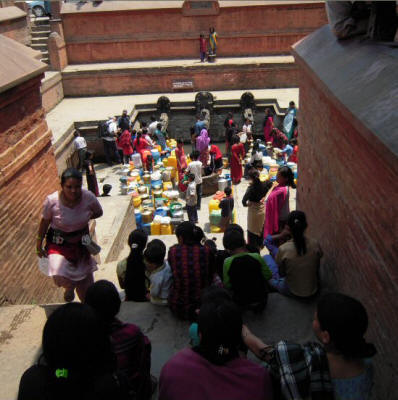 I went up to the top floor of the restaurant so I could watch the people in the square. I could watch the people at the watering hole.
I went up to the top floor of the restaurant so I could watch the people in the square. I could watch the people at the watering hole.
You have to dig over 20 feet deep for a water well, so most people have to come to this place to collect their supply for drinking, cooking, and washing. The water trickles out slowly from three pipes. Most people use plastic jugs, but some have beautiful brass containers to hold the water.
I tried to lift a brass jug that was full of water. I could not lift it! That was embarrassing. The local lady had a strap to carry it. She tied rope to the mouth of the brass pitcher, the strap went over her forehead, pot hung over her back low. They also carry it on their hip.
She had to carry that heavy jug half a km. Even the locals have to boil the water before drinking it.
All the women are wearing sari's. I saw a young girl with jean shorts!
After lunch, we found Hari with the car. We had an adventurous drive back to Kathmandu.
We are now in Kathmandu Durban Square. Here's a map of the area. I put red arrows by the places that I mention below:
.jpg)
You have to buy a ticket to enter this area. I wonder if locals have to buy a ticket or just tourists?
Gaddi Baithak (#26 on the map above) is the 1905 Greek design palace that is adjacent to the traditional design palace. The old palace was built in 1775. It is 9 stories tall. The King lived here 25 then built the pink building (now a museum).
In front of this palace is the Site Office of the "Kathmandu Metropolitan City Hanuman Dhoka Durbar Square". Right next to it on the map is labeled Basantapur Durbar. It was a very nice Souvenir Market - a no hassle area where you could wander around and look at souvenirs. This no pressure method sales method works the best for me - When the items for sale are displayed so you can see everything It would be even better is the prices are displayed. I actually found and bought a little brass spoon that says "Nepal". I paid the asking price 150Rs. I think that will be the cheapest spoon in my collection.
The shopping area was void of people, EMPTY. So much for keeping a low profile. Around this square I totally stood out. In the other area of Durban Square I was approached by many people trying to sell stuff. They are disparate for tourists.
Hippe.JPG)
The Maju Dega (#13 on the map above) is the "Hippy Temple". beside the Greek design palace.
Built in the last 17th century. This temple is the most impressive one in the storeyed style. It has a nine step brick base. It has beautifully carved wooden doorway, pillars, window and struts.
This place was "freak street" in the 60's and 70's. Many hippies were here. Surendra said there were many many hundreds of hippies staying here in the neighborhood around the square. Young people now still hang out and do PDA's here.
In 1973 they enacted a no drugs law.
Robert McNanamara's daughter hung out here. Robert (who "started the Vietnam War"!?) came here around '72 to find his daughter and take her home.
Surendra left me to wander around the square.
I climbed the steep steps to the top of the Hippie Temple. I saw a condom wrapper on the stairs! At the very top, around there was a group smoking pot. I smiled and put my camera down and turned around.
They know what they were doing was wrong and I saw them, but who cares. They certainly knew that I was not looking for any trouble so I wasn't going to intrude.
Next the Hippe Temple is the "Triokya Mohan Narayan". Built in 1690. Stands on a five-stage "plinth" and has three roofs.
Around the Kathmandu Durban square there was a group of westerners with a guide. I walked around and passed them since my had already 'splained to me the hippie temple.
Kumari-ghar means "House of the living goddess" (#25 on the map above) . A 3-storied quadrangle lavishly decorated with fine woodcarving. Built in 1757. The goddess is an incarnation of the goddess Taleju. The Goddess is chosen form the Goldsmith Class when they are 4-5 years old. The one goddess is selected. She never walks on the ground. She is celebrated at the Kunar Festival in Sept. She is the Goddess until she becomes a woman after menstruation. It is said that any man who has physical contact with he will die.
Here is a photo inside the pavilion of Kumari-ghar. She lives inside this building. Sometimes she appears in the windows. It is illegal to take a photo of the goddess.
KumariGhar2.JPG)
Kashthanopab Pavillion (#18 on the map above) is made of one tree. The name of the city was derived from this pavillion made of one tree - Kastamanda (?)HanumanStatue.JPG)
By the Hanuman Statue (#30 on the map above), "Gurgha soldiers are positioned. They are sent by UN the guard the entrance to the palace. Photo to the right ---->
I also took a picture (see below) of "Kal Bhairav" (#33 on the map above). It is a big colorful statue that people are praying to. It is huge stone image of Bhairav that represents the deity Shiva in his destructive manifestation. This is the most famous Bhairav and it was used by the government as a place for people to swear the truth. God Bhairon is known as a fierce god in Hindu faith.
KalBhairav2.JPG)
Behind the colorful stone image in the photo above is the Jagannath Temple (#31 on the map above). This temple dates back to 1563, during the rule of Mahendra Malla. The temple has a three-tiered platform and two storeys. There are three doors on each side of the temple. It is noted for the erotic carvings on its roof struts. I wrote in my journal: "OK I found those disgusting decorations on the building by the entrance to the palace. What is that all about?" So, Surendra explained that there are a couple of theories/stories about these carvings. They thought that the Goddess of Lightening won't strike the temple with porn and the other story is that the porn images with help with population growth - kind of an educational building then???
That sure was an interesting conversation on our walk back to the car.
It was a crazy drive back to the hotel. These roads here in Kathmandu are really really bad and very difficult to maneuver but Hari is a great driver today. He did great negotiating around the pot holes, people, motorcycles, and at one point a huge truck. A small boy jumped out in front of the car and Hari hit the brakes hard. The boy was not hit, but he sure way crying. Imagine that as your job to deal with that kind of driving stress every day. Yeow.
Surendra said his daughter was recently married and she is now living in Florida. I asked about the dowry: Jewelry, clothing (sari, jean pants), furniture, and 500,000 Rs ~ 6,000 in bank account. Wow.
I had read an article that said that in Kathmandu they only have 8 hours of electricity a day! See http://scoop.co.nz/stories/HL0803/S00068.htm. So I asked and Surendra said that they only have 4 hours of electricity a day. The hotel (and rich people) have their own generators so they have electricity all the time. Sure enough, at 4:15 and the power went off in the room/hotel. Then it came back on. I wonder if that was the switch to the generator for the hotel.
3:30 and I'm back at the hotel. That was such a unique experience today to have a private tour. As Irshad would say "first class".
So I'm in the shower and phone rings. They are bringing my passport and Chinese visa to the hotel at 6 pm. This is an incredible tour company. This is the first day that I have not had my passport on my person and I am ok with that. They were doing the legwork while I was being driven around in an AC car seeing the sights.
I arranged my stuff for the second part of by 3-part trip: the drive through Tibet. Tip: Just in case. If anyone gets sick on the bus it may get difficult to avoid the smell, so carry a dryer sheet with a fresh scent to inhale
I left a wake up call. I have to be ready and checked out by 5:45, no make that 5:35 (because everyone is always early on this trip). It is 7:20 now so if I ask for a wake up at 4:15 Ill maybe get 8 hours of sleep. Room 3014.
The air in the city is kinda yuk. Some people are wearing masks. My throat is definitely dry. Reminds me of Havana experience but not quite that bad. Im glad to be going to cleaner, higher air tomorrow. I can't wait.
Back to Top
Saturday April 25 - Day 9 (Drive Day 1) KATHMANDU to NYALAM (3750 m or 12,300 feet)- 96 miles (156 km)
This is what the itinerary said:
25 April Kathmandu (1300 m) Zhangmu (2,500 m) / Nyalam (3,700 m): 123 km / 156 km.
0600 Hrs: Early morning scenic deive to KODARI (Nepal Tibet border) through the beautiful Nepalese countryside and after necessary border formalities both at Nepalese, and hour adventurous uphill drive by truck (normally) or 2 hour walk uphill (in case of landslide) to Chinese immigration. Check-in to hotel or continue drive Nyalam.
We are supposed to try to drive from Kathmandu to Nyalam 96 miles (156 km), but if we make slow progress then we stop in Zhangmu 76 miles (123 km).
I guess if we had trouble and a long time to get across the border we would have stayed in Totapani (Zhangmu Hotel) at the border. Another similar itinerary said: "In case of road condition we may trek for about 3 hours on the other side of the border." Landslides usually only happen during rainy season June/July so we should be fine in April.
Surendra, my guide yesterday said that it's about a 4.5 hour drive to the border. There are landslides in June/July so we should be OK now in April.
This is my account of the day:
Departure from the hotel was supposed to be 6 am, but it was changed to 5:45 am, which really means 5:30. I was up early and had a croissant and a pack of oatmeal (aka "porridge") for breakfast.
Yup, sure enough, Hari was at my hotel at 5:30 this morning. I figured he would be early. I was just leaving the room when the front desk called. The hotel did not charge for the 10 minutes of Internet I used yesterday. So no cost to check out. Cool. My (previously stiff) neck was surprisingly better today. I took my one Aleve pill anyway. Its easier to take in the day and enjoy the experience with no pain.
So last night I opted against eating dinner. The vegetable noodles for lunch was good, then I had a couple spoonfuls of my Dark Chocolate Peanut Butter. I think Ive eaten half the jar so far. I laid down at 8 pm and went right to sleep. Im dead to the world and the phone rings. Is it my wake up call already? No, its 10 pm. The front desk is calling to check what time I am leaving. "5:45" I say. And I have a wake up call. "Yes, wake up at 4:45", "no, wake up at 4:15" OK. So try to get back to sleep. The air was blowing directly on me, and my throat is already dry form the day. I got up twice to turn the temperature up so the air wasnt so cool. I had a pretty good 8 hours sleep. I got up so early because eight hours is enough and Im trying not to rush myself in the morning so I can remain calm and really enjoy the adventure.
I hope there are other English speaking people on this bus.
So Hari picks me up and hotel and drives me to the bus. Theres only a couple other people here so far. 5:55 am and Im sitting on the bus. This bus will take us from Kathmandu to the China border. In China we will transfer to jeeps. My suitcase and everyones luggage is on top of the bus. Everything is tied down. I think I heard a beep from my lugggage locator. This is going to be a great trip. I think I heard there are 19 people and 25 seats on the bus. I was in the front row and decided to move back on row. Good idea. Single girl in the front now may have to share . Anyway. There are two Americans sitting across the aisle from me. And TG there are many other English speaking people.
I think I heard that we are stopping for breakfast. OK, the bus was very full!
A guide got on the bus and introduced himself but I dont think that many people heard him, and I certainly had a difficult time understanding. I think he said "I will get you to the border". OK. He is sitting next to the girl in the front row.
Yeow, I see a sunrise. I dont need/want to see that excepts on extremely exciting adventures like this one.
So the bus takes off a little after 6 am. This bus has very sqeaky brakes and one of those very funny sounding horns.
These some signs and things that I saw as we were driving through Kathmandu
"To-Let" as in "for rent".
"Playboy Whiskey. Play Hard, Play Safe" No actually the sign reads "Play Safe, Drink Safe"
"Yak Auto House"
"Agriculture Development Bank"
"Mount Everest High School"
I have a couple things in my bag because I have learned from past experiences. Its good to carry an airsick bag (acquired from the airplane, zip lock bag (learned from Russia Red Square experience), wipes (learned from Africa experience), water, some food (I always have my Frosted Mini Wheats)
I have to close my eyes so I can take all this in. We are in a huge jumble of a mess of vehicles jockeying for position to sqeeze through the smallest space possible in order to proceed forward on this journey. Just getting out of the city is the first step. Rush, rush, rush, drive fast, horn, sqeaky brakes, push through the next bottleneck with this big bus while motocycles skirt in and out floating around and beside the larger transports.
I saw a Dental Hospital and several colleges along this road under construction. Im not sure if I would called this 3rd world country, but 2nd world doesnt sound right either. This is how the majority of all people in all Asian countries live.
Whew, glad Im not in front. I dont want to be able to see the road. Hari driving the car seems like a piece of cake compared to riding in this bus ordeal. There is quick slam on the skreetching brakes to keep from hitting the car ahead, and at the same time, force the bus coming towards us over and off the road to the rubble on the side.
OMGoodness (OMG) the seats on this bus are positioned for very short people. My knees push up against the seat in front.
Sign: "Moonshine English School"
There is a wheat field, I mean many, many fields on many, many 3 foot wide terraces on the hill.
6:50 and we are climbing already. The road is winding, turning ninty degrees left and right, then a hair pin turn.
A bigger bus that is packed full of standing locals passed us.
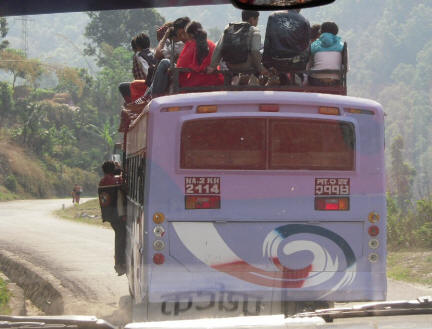
Are we in Sansa or Sanko town? Im glad I brought 2 journal writing pads. One book is full and I might fill this pad at this rate.
7 am now and and we are in Banepa. This town is 16 miles (26 km) east of Kathmandu, so we have only traveled 16 miles in one hour !?!
Sign: "Rotary Club of Kavre Banepa". Another Rotary sign, I guess its worldwide.
Now Im getting the feeling that this is what the road to Girardot Colombia (near Bogata) was like.
7:10 and we are stopping. We stopped at
Hotel Ravine Sunrise (Pvt.)
1 Thakuri Gaon in the Town? Of Dhulikhel
Tel 11-61482
Email: Ravine@wlink.com.npKathmandu Sales & Marketing Office Thamel Tel 262701
The hotel is mentioned on this web page
http://www.catmando.com/tn/dhulikhel.htm} Yeah! Breakfast! We all sat at a long table. Coffee and Tea were in themoses on the table. We had toast and a plain omelet with some nice potatoes. Our guide explained some things. I had a very difficult time understanding what he said, but I did get this much:
On the other side of the border, we will get a guide named "Lak Dook" ? in China.
Chinese time is 2 hours and 15 minutes ahead of Nepal time.
If you have fruit in your bag, you need to eat it before you get to China.
The road from Jangu to Nylam is being "reconstructed". It will take at least 2 hours.
I think I heard that you canget a porter to help with you luggage. Yeah!
He also said something like: "If China doesnt let you in, you have to pay to go back to Kathmandu." In 2007, one guest was refused entry.
On the other side, we will have 4 people plus a driver per vehicle. There are 24 people in our group so we will need 6 jeeps.
To change money from Nepal Rupees to China Yuan, we can either do it through the guide on the bus, or on the black market.
Its a warm day so far. I wonder if I will need my jacket later on this bus. 4 Americans I think. Denmark 4?, Germany 2 girls? Single lady from France. Across from me: Jon and Ali from Seattle Washington. Also met Sara who is traveling with a friend, Watson, from Australia.
about 8:15 and we we are back on the road.
Were in Panchkahal town. Maybe 8:30. We passed a shell of an entire bus that had burned. It was just sitting there in the road.
Sign at 8:35: "Kodari 70 km."
8:50 we passed "Bungy Nepal" sign.
Dolal Ghat town at 8:55. I saw a "Dololghat Picnic Area" sign.
Sindhulpalchok at 9 am. I sae a Chamber of Commerce sign for the town. I took a picture of the bus ahead of us. It was loaded with people on top, there is a guy hanging onto the side.
9:30 - 40 km to go. We stopped at another police checkpoint.
Now we're in big town. Big steel bridge across the river.
9:40 we passed a dam on the river. For power generation. There are lots of power lines drapped across the valley.
We are still following the river. It was on our left, but now it is on our right side.
9:20 30 km to "Kudari".
9:50 Barhbagi Town.
What a traffic jam. We are jammin. We have to back up the bus to get out of a little mess. A guy riding with us in our bus jumps out of the bus to direct the process. To signal the driver, the man hits the back of the bus twice. Bang, bank, back up a little, bang bang, back up a little more.
Jon has a GPS! He said that we probably could not get a reading here in valley.
9:55 another police checkpoint. Police looked at paperwork and something else from the driver. I think I saw the driver pass the officer some money. The driver got out and talked with the police behind the bus.
Look at that, the river is on the left now.
10 am, maybe 24 km. 10:05 stop the bus again. He said "short time; toilet break".
GPS Reading at 10:05
2748.617N 08553.199E Elevation 923 meters. Accuracy 15 meters
Hmmm, Kathmandu is at 1400 m (4593 feet) so that Elevation doesnt seem correct. Probably cant trust the position either.
10:20 and we are on the road again.
I had to decide whether to exchange money on the bus on the way to the border, or use a blackmarket person after we cross the border. Then I had to decide what to change: India Rupee, US dollars, or Euros. Hmmm. I decided to use up the Euros and exchange money in the bus. I was prepared with this handy (now outdated) information: China Yuan Renminbi is "cny".
1 Eu = 9.00 cny 20 Eu = 180 cny 50 Eu = 450 cny 100 Eu = 901 cny | $1 = 6.83 cny $10 = 68.34 cny $20 = 136 cny $50 = 341 cny $100 = 683 cny | 1 cny = $ 0.14
10 cny = $1.46
20 cny = $2.92
50 cny = $7.31
100 cny = $14.63
200 cny = $29.26
400 cny = $58.52
1000 cny = $146.32 |
First he converted Euro to Nepal Rupees.
100 Euro x 1.03 = 10300 Nepal Rupee (On May 12
http://www.exchange-rates.org/Rate/EUR/NPR had a rate of 1.07, so 1.03 is OK)Next, he converted Nepal Rupee to Chinese Yuan Renminbi
10300 / 12.3 = 837 Chinese Yuan. (The web site had 11.58 which would have given me 889 Yuan. 889-837 Yuan is difference of about $7 USD. Fine, that is his commission. That is price you pay for the convenience. Isnt that always the case when you change money to another currency.
10:45 we are crossing the Chaku Bridge over the river. Picture of it here:
http://wikimapia.org/3536449/Chaku-Bridge. Wikimapia had these Coordinates: 2753'1"N 8554'50"E for the bridge.About 5 minutes after we crossed over that bridge we were on a dirt road. Bouncy, bouncy. Very rough ride. There is a sheer drop off on our left. Motocycles are going just as slow as our bus. They have to negotiate the rocks.
Whew, better now. We were on some pavement again, then dirt roads again, then paved again.
10:55 we passed a power plant.
11 am we crossed "Phulping Bridge". Its a pretty arched bridge. Sign said it has a 67.7 m span. We passed another hydro power plant and dam.
11:05 "Welcome to Tatopani Hot Springs"
11:10 we just passed a beautiful high waterfall flowing down to the river below.
We are stopping the bus and parking in a big lot. There are many other empty buses are also parked here. We are in Zhangmu. This is from Wikipedia:
Zhangmu (Nepali: Khasa), is a customs town and port of entry located in Nyalam County on the Nepal - Tibet border, just uphill and across the Bhote Kosi River from the Nepalese town of Kodari. At "merely" 7545 feet (2300 meters) elevation about the sea level, Zhangmu has mild and humid subtropical climate, which is a rarity for Tibet. Trucks traveling on the Friendship Highway offload goods at Zhangmu and transfer them to trucks from the opposite country. The single narrow zigzag street of Zhangmu makes this an especially difficult operation.
This is where we exit the bus, get our luggage and walk to the other country. I let the guide know that I will definitely need a porter. A very anxious enthusiastic young man started looking for my luggage to be lowered from the top of the bus. Mine case we probably the last one and the biggest. This guy didnt know what he had signed up for. He was going to have to work for that tip.
Waiting for luggage unload, we took another reading. 11:25 GPS Reading:
40 00.00 N 115 00.000E, 925 meters.
Hmmm, that doesnt look like a good reading.
So we walk a short distance to Nepal immigration.
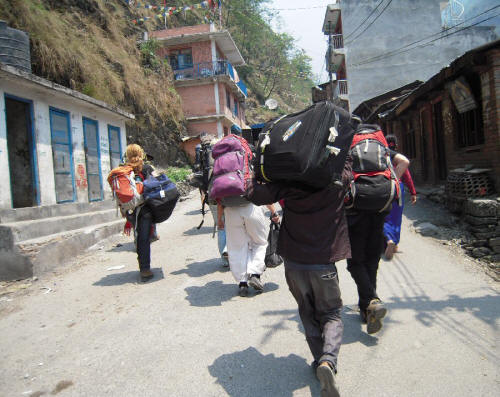
At Nepal immigration you have to fill out a form, show your original China visas, give them a copy of the Chinese Arrival visa, and get your passport stamped. Get your backpacks and and trek up the road a bit to the bridge. There is a big red line painted across the middle of the bridge to show the border. We were told not to take any pictures. How often do you get to walk across a border? I remember rolling my bag about a mile on dirt road to cross from Vietnam to Cambodia. No pictures there either.
So here we are, 24 of us on the bridge. The guy on the bridge starts collecting our passports. He removed the Chinese visa paper from the passport and folded it in between the next passport. After collecting about 10 passports and visas, the pile is a little difficult to hold, so he gives them to another guy who runs up the hill with them. We realize our passports are going somewhere, so a group of us follow our passports up the hill.
The first guy keeps collecting more passports and visas, then another group walks up the hill to the Chinese Arrival immigration hall.
All of our passports and visas were placed, no thrown, on a desk. The guy at the desk just stood there and stared at them. All 24 of us were lined up at the desk. Finally the guy picks up one passport, looks at it and asks for a girl from Denmark. Four girls from Denmark come forward, and the appropriate person claimed her passport. The passport is no good without the visa though, so now she had to search the pile to find the Chinese visa paper with her name on it. Ok, one down. 23 more to distribute and process. What a mess.
The officer gave the pile to our guide to divey out . Ok, now everyone had their own passport and visa again. Why were they collected on the bridge in the first place?
Now, one at a time, we go up to the counter. They take the original copy of the Chinese arrival visa, look the Chinese exit visa, and stamp your passport.
There were many Nepalese people going through also. They had IDs that they had to show the Chinese officer and they could walk into China. They carried what looked like 100-pound sacks of rice (via a belt that went around their head with and the sack precariously balanced on their back). They had to negotiate through our line of anxious travelers waiting to get through the border. The Nepalese porter guy with my suitcase went through the other line where the locals were directed. He took my case through and placed it on the x-ray belt. It appeared to go through with no problems. That was surprising based on what happened to some others in the group.
I was surprised that my case made it through the xray with no problems because I had two thick books in it. Maybe since the Nepal guy was "claiming it was his luggage" ? then they didnt check the x-ray as closely as they checked the others in our group.
12:05 and I finally got through the line with my stamped passport and I find my smiling porter with my suitcase on the other side. The guide told me not to pay (tip) him until he put the bag in the jeep. So we sit there and wait and wait and wait. We are waiting because the Chinese are really scrutinizing the contents of the backpacks.
Several people had to retrieve the books from their pack. If Taiwan, or anything objectionable about Tibet or Dalai Lama was mentioned in the book, they had to rip out the "offending" pages. For example, "Taiwan" was mentioned on the cover of a tour book, so the cover was ripped off. Pages and chapters were ripped out of books. What the heck!?! They really control the information flow.
We were held up the longest by an Asian girl in our group. Rebecca was born in the United States and she has a US passport. So whats the problem? Seems that her parents were born in Taiwan. That appears to be an issue. And theres a small problem that they believe the US passport is not real. She has changed her hair so her photo is different from how she looks and now and it is also different from her drivers license. So Rebecca got stopped at the border and questioned. She said there actually a moment when she did not expcet to get into China. Finally, she appears to make it through. No, maybe not.
1:20 and we are through Chinese immigration. We all walk up the hill to find the jeeps. The porter guy loaded my case in back of a car that needed a fourth person. He carried it on his shoulder for most of the way, but he did wheel it across the bridge. Anyway. He wrote "300" on his hand with my ink pen and he said "200" to me requesting a tip. On the bus when I hired the guy, the guide said that the guy was his friend, but do not give him any more than 150 Rs. OK. So I had a 100 and 5 tens. He asked for more, of course, but when I showed him the money it looked like a lot so he walked away happy.
So we are in the cars,four people to a car and we are sitting there waiting. Immigration is requesting to talk to the tour guide. They want him to collect all the United States passports in the group. I guess they want to compare all of them to see if Rebeccas (?) is real. Yes, its genuine, so let her through and quit pushing your authority around (because you can).
OK 2 pm and we are finally off in our jeeps. 4 of us and a driver in each vehicle. I have my passport back. We are on a very very rough road that is under construction. OMG what have I gotten my into on this trip?
At 4:30 we FINALLY stopped for lunch. They gave us 2 hours in this little town. Four cars parked on the crowded, steep, narrow road and our car parked further up on the street. Some folks walked into the first restaurant that they saw. And three of us though better to find the guide and go to the place that he recommended. He also needed our exit visas for something.
Lunch I got vegetable noodles. It was very good! A lot better than what I had yesterday in Kathmandu. That was a pleasant surprise. The bathroom was not a pleasant surprise. Tie up pants so they dont fall on the ground and squat. Oh joy. Such a smell also!
This group of people seems like a wonderful collection of very seasoned travelers. Im really enjoying this, except for the bouncy roads. Such as it is.
After lunch I went outside. I sat down on some steps to to write. A couple of girls stopped to watch me write. I gave my pad to them, "Kalpana" wrote her name in my book. I wrote "T I B E T" and they knew the letters.
There was a lady that was walking her kids around the block. For exercise maybe. They passed in front of me twice. Seems an odd place for exercise on this crowded narrow road.
This place/town is built vertically up the mountain kindof like Valparaiso, Chile. It wasbuilt on a hill, with steep inclines between the buildings.
I switched to Chinese time: 6:20 pm another GPS reading from Jon.
37 00.000N, 089 00.000E, 925 M
Hmmm, that doesnt look like a good reading, again.
6:30 pm and we are back on the road after lunch.
The first drive after lunch was short-lived. Now we are sitting at a dead stop because there are so many trucks in the road that no one can pass. We've been sitting here maybe 10 minutes so far. All the drivers in our convoy put together a plan. They made a stack of stones about a foot high on the far right side of the road, so we can squeeze by the truck jam by four-wheeling it over the stack of stones.
7:15 and we are stopped again. We are heading up. We are driving on the side of a mountain road that it is currently being paved. We had to park our convoy of cars very close up against the side of the mountain to give as much room as possible the trucks to get passed us. The trucks drive slow, careful to avoid falling off the side of the cliff.
The picture shows our parked convoy hugging the mountain.
Notice the red truck coming around the bend. 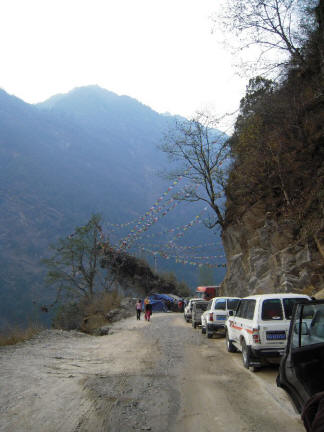
| The truck slowly passed our parked convoy.
This photo shows how close the truck comes to the side of the cliff.
Yeow! 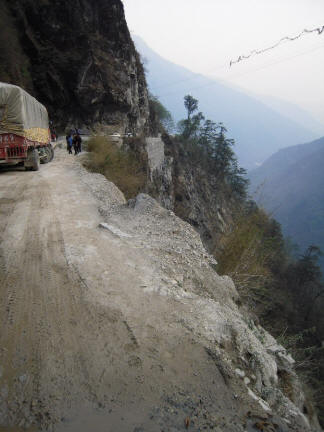
|
So last month this story was on CNN March 1, 2009: Nepal: 9 dead after bus plunges into ravine http://edition.cnn.com/2009/WORLD/asiapcf/03/01/nepal.bus.crash/index.html#cnnSTCText
By Manesh Shrestha For CNN
KATHMANDU, Nepal (CNN) -- Nine passengers were killed when a bus plunged about 2,300 feet (700 meters) into a ravine in Nepal on Sunday, police said.
Two others are missing and five are injured among the 17 traveling on the bus in Baitadi district, west of Kathmandu, police officer Binod Kharel said. More details were not immediately available. Old buses, poor roads and overcrowding cause frequent accidents in the mountains of Nepal.
We were in a bus up to the China border, but now we are in (safer) Land Cruisers on this road. There are no seat belts though...
This road in Tibet is alot like Bolivia's death road.
Sheer dropoffs. Very scary..
Lots of
traffic. One good thing about all this traffic and stopping is that we will have ample time to acclimate to the altitude at this slow rate of speed.
8 pm and we are finally rolling again. We had to wait for the trucks to clear the road. We were stopped for about 30 minutes.
OK, this is a whole lot more treacherous than the road in Sri Lanka. At least in Sri Lanka they kept cars moving forward on the road that was under construction. That is not possible here. We drove 3 awful minutes and now we are stopped again.
8:10 are we rollin for 10 rough minutes. At 6:20 and we are on smooth pavement. The goal seems to be to drive as fast as possible when possible on these windy roads. Like a "bat out of hell" to make as much forward progress in a short amount of time because you will have to stop and wait again later.
8:45 and we arrive in Nyalam.
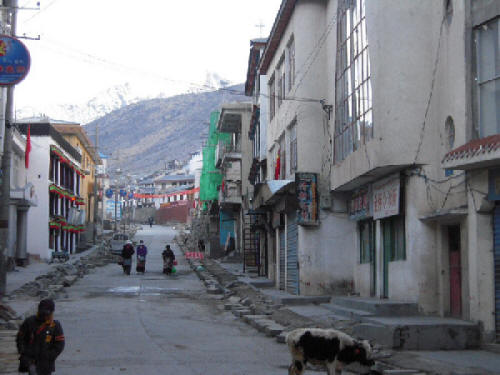
The view up the street from our hotel in Nyalam.
From Wikipeida: Nyalam is a small Tibetan town near the Nepal border. It is 35 km from Zhangmu town in the same county, which is the point of entry of Nepal. Nyalam is situated at 3,750 metres (12,300ft) above sea level. A town of stone buildings and tin roofs, it is nicknamed 'The Gate of Hell' by the Nepalese traders because the trail between Nyalam and the Nepalese border was so treacherous to negotiate.
Yeah, I imagine that road was scary for truck. We just rode on that road and I have to concur. It was treacherous.
First thing in town, we stopped to get petrol:
5.75 CNY per liter x 78.43 liters = 451.00 cost
1 liter = 0.26 gallons so 78 liters is about 20 gallons.
$.84 USD per liter x 78.43 liters = $66.11 USD. Yeow! Thats about $3.30 a gallon.
or
451 CNY total for 78.43 liters, so $66 for 20 gallons, 65/20 = $3.30 a gallon. I paid $2.51 for a gallon of gas in Atlanta yesterday.
After getting gas, we drove down the street to our hotel in Nyalam. Its the Nga Dhon Hotel. Our convoy of six Land Cruisers squeezed into the courtyard in back.
There was huge drop in the temperature! Its very cold out. We grab our stuff and get shuffled to a room. There are dormitory rooms, single, and twin rooms in this hotel. No heat. The toilet is down the hall. It is communal with men and women sharing. At least there is a door to the squat toilet.
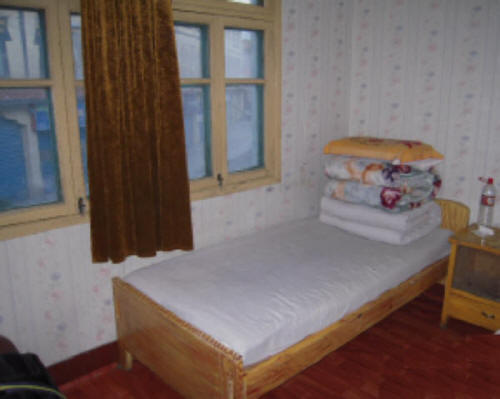
So he directs me to a room where several other girls are unpacking. I paid dearly for a single room on this trip, so I indicated that I should not be sharing. I probably could have survived in the group room, but.... I had the Prepaid Tour Voucher in my day pack. It indicated "Room Type & Meals: 1 SINGLE ROOM on BB basis. April 23-May 2, 09. Kathmandu and Tibet Drive out fly in with all accommodation as per itinerary" Whew.
No problem, there are many little rooms in this little building. So I carried my heavy case it up the first set of steps. The very nice lady working there carried it up the second set of steps. My room had a bed and small couch. 9:20 pm and Im in bed, very tired. Whew again.
In the photo, notice the pile of bedding. The
re is no heat in the room, or the entire building, but the bed covers are VERY WARM and there was electricity! It was very very cold outside. So it's a cold walk to the bathroom.
10:30 pm in Nyalam. We are at over 12,000 feet. SFSG (So far so good). So tired . See how tomorrow goes. Sleep now.
Interesting read from
http://www.triniview.com/India/FriendshiphywayText.htmMost people will feel the effects of Altitude Mountain Sickness (AMS) in varying degrees. AMS begins at 6500 feet (2,000 meters), becomes pronounced at 11,500 feet (3,500 m) and requires adjustments for each 400 m above that. If not treated quickly, it can be fatal. The 1000 km long Friendship Highway, from Kathmandu to Lhasa, goes through seven passes over 3500 meters, four of them rising over 13,100 feet (4000 m), one over 16,400 feet (5000 m). Two years previously I had suffered from AMS on the eastern edge of the Tibetan Plateau and on this trip I expect it would be the same. ..
In the night, even with two quilts, it is cold. It is difficult to breathe. I lie awake, shivering, gasping.
In the morning, several women are weeping from the effects of AMS and the rough roads: headache, nausea, vomiting, inability to sleep. They want to go back, they want a plane, they want to die. Andy is too weak to walk. Benoit, a bubbly Frenchman, hands out Dymax to help counter the effects.
For their safety we should descend to a lower altitude. Nobody mentions that within hours we will ascend to 16,500 feet (5050 m) at the Gyatso la Pass. We have a Chinese breakfast: rice soup, shredded pork, pickled vegetables, steamed cake and tea, then depart at 9 o'clock. ..
Shigatse looks like a Chinese town with a Tibetan flavour. Only in these towns do we see people up close or see traffic. On the road we encounter perhaps three vehicles a day, jeeps speeding past us or going the other way. I sleep fitfully, a budding headache thumping away at the fringes of my consciousness. At breakfast, all the women are visibly worse. None could sleep, some are crying. Benoit's Peruvian wife, Marcela, looks cheerful but only later in Lhasa would she admit to having felt ill along the way. Shigatse lies at 12,800 feet (3900 m), lower than New Tingri, but it hasn't helped..
Then we are over the last pass, Kamba la Pass, at 15,700 feet (4794 m) and descending into a green valley with orchards and fields irrigated by the Kyichu River.
Back to Top
Sunday April 26 - Day 10 (Drive Day 2) NYALAM to LHATSE 150 miles (244 km)
This is what the itinerary said:
26 April Zhangmu / Nyalam Tingri (4300 m) / Lhatse (4350 m) : 225 km / 244 km.
Day drive uphill to the highest plateau of the world with the typical view of Tibetan landscape offering sheer feeling of standing on the roof of the world crossing over LALUNGLA 16,581 feet (5054 meters). Weather permitting, you can see breathtaking panorama of beautiful Himalayan ranges including MT CHO OYU 26,906 feet (8201 m) and MT XISHAPAGMA 26,286 feet (8012 m) but dwarfed by the vastness of the Tibetean plateau. From TINGRI, one can enjoy the magnificence of MT EVEREST 29,028 feet (8848 m). Overnight at hotel.
If we make slow progress then we stop in Tingri 140 miles (225 km), otherwise we will continue to Lhatse 150 miles (244 km).
Another web site with some pix of this drive is here: http://www.bugbitten.com/blogs/travel/jillyandpaul/Tibet.html
This is my account of the day:
I got up around 6:30 to use the squat toilet. That was a very good idea.
The bed was hard and the covers were extremely warm. I had to take my sox off it was so hot.
Breakfast 8 am. We were served Tibetan bread and an "omelette" - a thin egg the size of the bread. I needed to put jam on the bread and sip of water to get it down.
Depart 9 am, no make that 8:55, and we are on the road.
I lost my wonderful soap. I wish I hadnt lost the soap. Such is life. Deal with it. Boy did I screw up buy bringing all this "just in case" stuff that I probably wont need. But that is why it is called "just in case" stuff. I should have left my case in Delhi and packed a little bag for this trip. That case is very heavy, but I suspect that some of those back packs are also very heavy. Anyway, I carried it down the narrow stairs this morning.
Im feeling fine again today thanks to my drug of choice: I popped two Tylenol this morning.
My toes are going to freeze today. We have heat in the vehicle. No air conditioning, but we do have heat. Heat is good.
I am really in awe of these mountains. They are much more spectacular than the Rocky Mountains in the USA. Were at 12 thousand, going up to 16,000 feet today. Then its all downhill from there. If we all can survive today, then we have survived the top of the world.
9:30 am GPS reading
28 15.370N, 086 00.857E, 4120 meters, Accuracy 8 meters
13,571 feet
.JPG)
My car companions are so cool! Peter, Mille, and Huub. They insisted that it was OK for me to sit in the front again today. I am taking photos and writing as much as possible so we can all remember this experience!
Everyone seems to be doing fine with the climb and the altitude so far. I have to keep reminding myself to keep breathing in big breaths to get as much O2 as possible to avoid headache. Some other folks arent fairing so well. Some people in the group did not have a good sleep last night. They were up with sick feelings and a good barf helps you feel better. Oh yes, the always-keep-handy barf bags are even being used in some of the cars. Were going higher still.
If youre thinking about doing this trip look at getting a prescription of Diamox. Some people had it and did not need it so they gave it to others in our group and it seems to really help but you have to request more pee stops
Too funny. So our driver doesnt speak a single word of English. We see and animal. Peter points to it and says "Yak?". The driver says "Yup."
There is no green anywhere. Its all sand barren landscape on the mountain side around here everywhere. The dirt road has rough washboard bumps. It seems like it will be paved soon. I saw a cement mixer.
.JPG)
9:45 - Ten minute stop to take photos of a village . Stone house with a running stream. There is a layer of ice on top of the stream.
.JPG)
058.JPG)
Photo by Karen Clapp
The children here in Tibet have are very kind and not pushy at all. Not a single person begging so far has done or said anything to insult or attack me. That experience with the vulgar and rude boy at Angor Wat is forever ingrained in my mind changed the whole feeling of the visit. Here the children hold out their hand, realize that they are not getting anything, then just stand there and look at you.
There are fields here. What are they growing? There are prayer flags in the fields. Chinese flags fly on the corner of the buildings. Some buildings have the Tibetan prayer flags on poles in the corners.
We are climbing, but it is gradual. Were still on a dirt road. Occasionally well drive by piles of rocks along the road:
.JPG)
.JPG)
Then Ill see a group of workers seemingly in the middle nowhere. Here's a group having some lunch:
The use the rocks to construct the drainage curbs at the side of the road. Here's a photo of the carefully constructed curbs on each side of the road.
.JPG)
After building the curbs, the next step is the pave the road!
I see beautiful snow-capped mountain range behind the sand mountains!
11:00 am GPS reading
28 31.004N, 086 10.045E, 5145 meters, Accuracy 13 meters
16,880 feet
.JPG)
.JPG)
WOW! That stop was AbFab! The strong wind almost knocks you over. The flags flying in the wind. The feeling of standing at the top of the world. But the road and landscape is not what I expected. Barren is all I come up with at this time. At this altitude.
That was invigorating when we stopped at all those flags. The strong wind so you just want to get photos and just get back in the jeep. Actually, it is a Toyota Land Cruiser. 4 wheel drive and have definitely needed it. You drive on road, then ahead on the road you see stones that block the road. You are forced to turn down to a very bumpy secondary temporary road, turn, then get back up on the main road.
We passed two bikers, as in "bicycle", not "motorcycle". We saw the first one on the highway, then more followed. So weve seen 4 bicyclists so far. 11:15 am now. They are definitely not riding road bikes. The road is washboard dirt and stone so you need hearty mountain bike. We saw all the bicycles in this one area. I appears that that they have a designated "start point". I'm guessing that start point is the banner placed above the road in the distance in this picture:
.JPG)
So we go downhill from here. We snake our way around the valley:
.JPG)
So far, it looks like everyone in the car made it without feeling ill effects. You can definitely tell the air is different. The air is very very dry. It feels like the skin on your face is tightening.
OMG 3 more day of these bumps! What have I gotten myself into???? I'm not sure that I can do this!!!!
11:45 I see a road sign that said to go straight to Tingri. This is not for the faint-hearted. 150 miles of of these bumps today. Holy sh--!
11:35. We stopped and all 5 of us jumped out for a well-timed break. Boys on the left, girls on the right. Mille and I found a great squat spot. Were basically out in the open, dirt mountains and endless seas of sand stone and rocks and boulders. Im sure that no one saw us. Whew! Wet those stones.
11:50 GPS reading:
28 44.064N, 086 08.942E, 4513 meters, Accuracy 11 meters
14,806 feet
We are currently stopped. Im not sure why. Doesnt really matter. Im still feeling fine, but I can tell that I am tired. Im getting very hungry. Thank goodness I have these frosted mini wheats and some water. I hope lunch is coming some time soon.
12:20 were still sitting here. We need to read the odometer in the morning tomorrow so we can get on idea of what distance is left to go. This is not such a good display of their beaurocracy. We are already in China, so why cant we pass?
The konundrum with the passports to enter the country was also not so good way to show foreigners how this country works. It will eventually get settled, whatever is going on.
12:45 finally moving again.
2:15 we are on pavement!
.JPG)
The pavement didn't last very long. We were right back on the dirt roads...
2:17 stop for lunch. GPS Reading at lunch
28 35.070N, 086 36.757E, 4355 meters, Accuracy .. meters
14,288 feet
Here's a picture of the "restaurant" where we ate lunch:
.JPG)
This is what it looks like inside:
123.JPG)
Photo by Karen Clapp
Im sitting here in the restaurant looking around the room at everyone waiting for their food to come. We are a battered and beaten group of people. That was a rough ride today and this is only the second day of driving!. The first day it was so treacherous we had to go so slow we didnt get so beat up. This second day, our car fell behind when we stopped for a pee and photos of Everest (?).
The noodles came first for lunch. My fried rice was OK. Im not incredibly hungry, so Im learning to eat less. (actually it is the altitude that takes away your appetite).
There are 5 locals here pouring over a "Tibet" guide book. They found the map in the book and one man was reading out loud some of the city names. The pictures are also interesting to them.
Oh yeah, the bathroom out back was worth a picture. Two raised rooms, a rectangular hole cut in the cement. I heard sometimes there is big pile of frozen shit below. Lovely.
Our guide said that we will have dormitory style rooms again to night. I cautiously inquired about a single and he seemed to indicate yes. Well see. I think Ill put out everything that I need for next two nights in my small bag. But maybe shouldnt leave the suitcase in the car? Ill ask him tonight.
4 pm and were back on the road. We have 3 more hours of driving, I mean riding.
Sign: "Tingi County 66 km"
We have one more Army checkpoint to go through so that could take awhile depending. We are not supposed to take photos at the checkpoints.
Sign: "5186". There are cement markers along this road. "5185" marking kilometers.
Man, I sure hope the next three days arent like the first two.
About 5, we stop at Army checkpoint around marker 5130. It was quick. We had to all go inside, they had a printout of our names, show your passport and visa they checked off your name on the list.
The km numbers are going down. There is snow all over at 5110 km.
5:25 pm we crossed the Bridge Luo over the Luo River.
6 pm - Arrive at the LA LUNGLA pass. GPS reading at the 5081 marker:
28 57.117N, 087 26.276E, 5265 meters, Accuracy 16 meters
17,273 feet
204.JPG)
Photo by Karen Clapp
The sign says "You are now entering Qomolangma National Nature Preserve". The other side of the sign didn't have any writing or pictures. I took a picture of that side, so I'm glad Karen took this photo of the other side of the sign We approached the sign from the other side - so I guess that means that we were just "leaving" the Nature Preserve.
FYI: Mount Everest, also called Sagarmatha (Head of the Sky) or Chomolungma, Qomolangma or Zhumulangma is the highest mountain on Earth, as measured by the height above sea level of its summit, 8,848 meters (29,029 ft). The ascent via the southeast ridge begins with a trek to Base Camp at 5,380 m (17,700 ft) on the south side of Everest in Nepal.
It was incredibly windy!
They said that we should be able to see the Himalayan ranges including (Everest) MT CHO OYU 26,906 feet (8201 m) and MT XISHAPAGMA 26,286 feet (8012 m). Maybe that is Everest in my picture below?
.JPG)
6:15 I took some pix of valley that we are driving through with my old camera.
I guess we pass through (or by) Tringri on our way to Lhatse.
Tingri or Dingri or Dhingri is a town in southern Tibet. It has a population of around 523. It is often used as a base by mountain climbers preparing to ascend Mount Everest or Cho Oyu. It is at an altitude of about 4,300 metres (approx. 14,107 feet). The old Shekar Dorje Dzong, or fort, is above the new town and used to enclose Shekar Chode, a Gelug monastery which was completely destroyed but is being restored. It is known for its spectacular views of Mount Everest, Mount Lhotse and Mount Makalu which lie around in what is the highest mountain group in the world.
Around marker 5056 there were turns in the road! Its nice to finally see other roads rather than just the road that we are on.
6:30 we arrive at the hotel in Lhatse. Our jeeps pulled in behind and parked out back. We stayed at "LHATSE Tibetan Farmers Hotel" in Lhatse. When we arrived, there was entertainment. Dancing in this courtyard! Very nice.
.JPG)
I think there were 4 rooms of 4 each for our group. Yeow. I guess if you just carry a back pack that is do-able. I had a room upstairs. OMG, you definitely get what you pay for and I paid plenty. I have to admit that Im not a backpacker for this trip
Its 7 pm all Im all situated. So there is a bowl and customary container of (very hot) water that they provide in the room, so I can have a nice "bath". I wiped all the grit and grime off my body. That water sure was dirty! Oh yeah, I need to comb out my hair. I havent done that since last night. Its so wind-blown today. I put it up when I went outside but had to let it down to keep the hot sun from burning my right ear. I got SO HOT in the car today. We were driving north and the sun in the east. Does it rise in the east and set in the west?
I did not need my heavy coat or gloves today. I also do not need a lot of other stuff. I separated out everything that I need for the next 2 nights into a smaller bag. So if its safe I can leave the case in the car for 2 nights.
While driving today I saw the sign for the turn off to Mt. Everest. Cool.
There is no way that I could do this if I had to scrunch into a little room. I remember Dixie on the 1993 trip to China. I couldnt fathom paying the single supplement 15 years ago but its all very different now. I dont hesitate to pay it for peace like this. Better to help tolerate, I mean ENJOY the trip. China is nice, but how shall I say this, Im not enjoying it as much as some other countries that I have experienced. I dropped 8 pounds the last time that I was in this country. Looking like I might do the same again. And Im doing a Triathlon 3 weeks after I get back to Atlanta. Yeah, right.
I think several people were feeling the effect of the altitude today. This is really really HIGH! The highest that I have every been (without Marijuana).
My small headache today was because of no food, and perhaps the altitude also.
Man, when did I buy that tube of peanut butter? Trips ago I have carried that tube of PB many places for just in case Well, I finally enjoyed pb and crackers for my dinner snack tonight.
OMG the trip isnt even half over over yet. It seems like its been extremely long. Two more nights in these podunk unique with character places. Yeow. Toilet is down the hall. Squat. Lovely.
Back to Top
Monday April 27 - Day 11 (Drive Day 3) TINGRI / LHATSE to XIGATSE 150 miles (244 km)
This is what the itinerary said:
27 April Tingri / Lhatse Xigatse (3900m) : 244 km
Continue scenic drive crossing over the GYATCHU LA (5220M). This is the highest pass en route to Lhasa via LHATSE from where a road to MT KAILASH bifurcates to the west. Overnight at hotel.
Why did they use that word "bifurcates". I had to look up the definition verify what it meant: Bifurcates - "To cause to divide into two branches or parts." OK, so I would have written it this way. And the description should include meters and feet if you want to Americans to go on this trip:
Continue scenic drive on the Friendship Highway. Today we cross over the highest pass on route, GYATCHU LA (5,220 meters or 17,125 feet. We travel to Shigatse via Lhatse on a road that also splits to go to MT KAILASH. Overnight at hotel.
This is my account of the day:
Woke up to barking dogs again today. Thats rural life.
This morning it looked like there was another group of jeeps parked in the front court yard. All of the vehicles are packed in tight in back and in front behind the locked gates.
Breakfast at 8 am. Tibetan bread again (2 small round pieces) and an egg. There was hot water in the thermos and a jar of instant coffee on the table. I added my Splenda sweetner which made nice pretty decent cup of coffee. I could not eat the bread. Someone looked into the jam jar, and determined that it did look safe. So I put the bread in my bag for now so I can eat it in the car later.
Depart 9 am
Were on the road again! This group is the most on time that have I ever seen. Usually there is a slacker (and yes, that has been me at one time) but not here so far. These drivers have a good time together. They try to pass on the road but the front one wont let him pass so we finally drop back. Its a game they play I think to make the drive more interesting. There really is absolutely not much see except beautiful mountain range everywhere, all around us for the third day now.
There are
24 people in our group and 16 of those people are single women on this trip! What an inspiration for adventure travel. It's unusual to see single men traveling on their own. It's so easy to meet people on the road who are going to the same destination. I found my soap. I definitely have too much to keep track of.
9:20 - The driver pointed to the Tachil monastery on the hill to the right. He points and says something, then I show him the word on my printed itinerary and he says "Yes". Then he held up 2 fingers and said something else. Huup determined that he was communicating 2 hours drive time to the monastery or "mon-as-try" in different pronounciation.
So the other people on this trip will probably laugh when they read this I have finally got these squat toilets figured out and they arent so bad. I was facing the wrong direction before! It works better when you do it correctly. Then you use a bucket of water to swoosh everything down if you miss the hole. And dont put paper in the hole that goes in the bucket.
9:35 GPS Reading at Tola Pass ("Tse" ? Pass)
29 04.4717N, 087 58.842E, 4537 meters, Accuracy 7 meters
14,885 feet
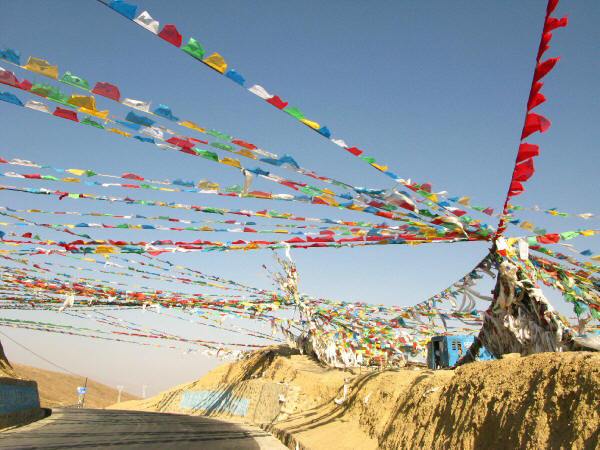
Photo by Karen Clapp
We stopped at the pass for about 10 minutes. Yeah it was cold! I need my wool sweater again.
Now I'm a little confused and a little frustrated that our guide does not speak good English and our driver doesn't speak any English. I tought someone said this was Tola Pass, but it was spelled with "Tse". The itinerary said we would see "GYATCHU LA (5220M) ", but this place was only 4537 meters high.
India Mike had a different photo of Gyatchu-La here http://www.indiamike.com/photopost/showphoto.php/photo/1896. He writes:
--If you want to experience altitude sickness while riding in a bus, this is the place to go--
--There were about 6 people vomiting through the window, including myself on the Kathmandu-Lhasa road, between Xegar & Xigatse : Gyatchu-La (5220 m), the highest pass en-route to Lhasa via Lhatse
Whatever.
A couple people in our group are taking Diamox helps to tolerate the altitude buy makes you wan tto pee more often, Its a good to bring it on the trip just in case. Ive been OK with Tylenol and Advil so far. Thats my drug of choice. And I need to keep drinking more water.
OK, Im ready to start coming down, but not until tomorrow. I switched to my backup camera today and tomorrow. Want to save the battery on the other camera for Lhasa. I can replace AA batteries and I cant recharge a battery for the next 2 nights.
I wonder if there was ever been any Tibetan currency?
Finally were on paved roads!!!! Nice. There are carefully crafted drainage ditches on each side. Bumpy brown mountains in every single direction. And no trees. There are power lines snaking through the valleys. Scrub brush on the ground. There may be an occasional spot of green. Otherwise, all reddish dirt and stones. But it looks like the land is all laid out in fields.
Wow, we passed a small area with green TREES!
This is truly amazing driving for 3 days so far seeing mountains everywhere to entire time. I see small patches of snow within the brown crevasses. There are marks on the mountains where boulders have rolled down.
I can definitely see why China does not want to free Tibet. With all this fertile land and beauty. China is going to get everything they can out of this land. There is no way they will Free Tibet. This area is also the source of the water for almost half the population of the world (India and China). I'm betting that water will be more expensive that petrol some day. Tibet is a gold mine and China is milk it for all it's worth.
11:16 GPS reading (1.6 km from Shigatse)
29 11.978N, 088 47.851E, 3911 meters, Accuracy 10 meters
12,831 feet (Wikipedia said 3,840 meters (approx. 12,598 feet)
We stopped for a toilet break. Find a deep crevasse to hid your bum.
Everyone was out of the cars and the drivers were congregated together. It seemed a long time and sure enough someone else thought also. Mille started honking the horn in our car as a message that it is time to go we have stopped long enough. Usually its the drivers doing the honking. Our driver sure does like his horn to warn others we are coming. That was funny. So get back on the road and we see a sign "Shigatze 1.6 km" We were to close to the hotel when we stopped!!
Town is also spelled "Xigatse" and is pronounced "Shegatse".
From Wikipedia: Shigatse (official spelling: Xigaz; other spellings: Rikaze, Shigatse, Shikatse, Zhigatsey , is a county-level city and the second largest city in Tibet Autonomous Region, People's Republic of China, with a population of 80,000, about 250 km southwest of Lhasa and 90 km northwest of Gyantse. It is the administrative centre of modern Xigaz County in the Xigaz Prefecture, a region of Tibet.
The city is located at an altitude of 3,840 metres (approx. 12,598 feet) at the confluence of the Yarlung Zangbo (aka Brahmaputra) and Nianchuhe (Nyang Chu) rivers in west Tibet and was the ancient capital of -Tsang province.
Wow what a difference in this town compared to the other towns where we stayed the past two nights. China has not "rebuilt" the other two towns. But Shigatze, what a change! This town has big wide paved streets. Clean structured buildings. This layout is much better for controlling crowds....
11:45 Arrived at hotel and checked into the room. We are staying at the Oomoljungme Friendship Hotel
2 to a room. Im with MarieJo. The woman who has the least amount of luggage. Go figure. The guide opted not to leave my case in the car. So the driver carried it up to the room on the second floor #203 Nice room with 2 beds and an attached bath with shower.
I dumped my bags and left MariJo to take a hot shower and have some privacy. Believe me I know how precious that is. She has been staying the dormitory rooms for two previous nights so far. She said she never buys water she just drinks the hot water that they provide. Thats courageous. She's a rock climber. She is courageous. Seems like if they dont boil it long enough, it will kill the bacteria, but not the spores (Jon said). I guess you deal with that little problem later.
I went for a walk out out on the (deserted) streets. The guide told us not to go up the mountain to the left, so I went right. I found a great place and I'm sitting here on the curb outside the Dechen Palace. A huge bus with maybe only 10 Japanese ? tourists just came out of the palace.
So share tonight (D11) and tomorrow (D12). Thats OK. Then Im single again for the duration 9 more nights of this trip. Whew. Thats a long time. As of today, this trip is only half over. I love not doing laundry. I just put the dirty shirts at the bottom of the suitcase.
It's a very comfortable temperature. Maybe 68 F. Just a teeny chill when the wind blows. Otherwise calm. Calm town also . It doesnt seem to have that busy dirty feeling as the other (Asian) towns.
So I'm sitting here writing and (can you believe this) enjoying the tranquility of the city. That seems like a first for an Asian city. Peace and quiet. A man saw me sitting here and stopped his motorcycle. He sat there awhile and waved at me. I said "Hello". He came over and watched me writing. He made a motion like he wanted to write so I gave him my pad. He wrote his name in Tibetan squiggles. I tried to repeat what he said "Drishi de Lei" I think.
Im having trouble discerning if a person is Tibetan or Chinese. It seems such a jumble of culture and language for me to comprehend. I can only appreciate the situation and accept it as it is.
I am going to run out of paper in this writing pad....
GPS Reading at the Hotel in Shigatse
29 15.562N, 088 52.222E, 3912 meters, Accuracy .. meters
12,834 feet
3 pm we depart hotel for the monastery tour. We walked less than 10 minutes. It was a short distance down to the end of the street that our hotel was on, turn right, walk about 2 more blocks to the entrance of the Tashilhunpo (aka Tashi Lhunpo) Monastery http://www.tashilhunpo.org/ also
http://www.china-tour.cn/Shigatze/Tashilhunpo-Monastery.htm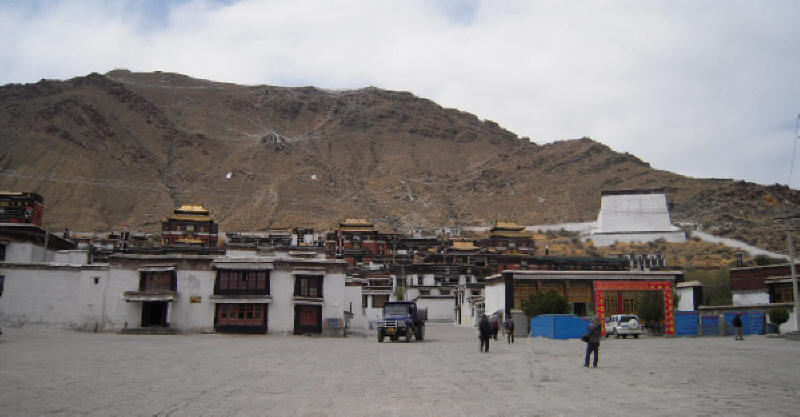
After climbing the hill, a closer look:
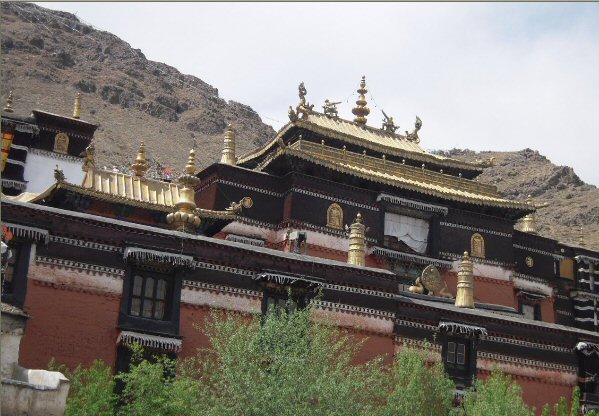
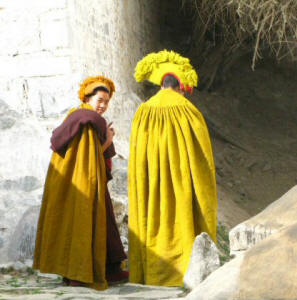 One of the four "Yellow- hat Sect" monasteries of Tibetan Buddhism.
One of the four "Yellow- hat Sect" monasteries of Tibetan Buddhism.
Founded in 1447 by the First Dalai Lama, Gedun Drupa.
There is a "recongregation" hall where the 5th to the 9th Panchen Lama's stupa and chapels, the golden stupa of the 10th.
The highest sitting Maitreya Buddha statue in the world made of gold and copper. "Gilded Stupa Sisum Nangyal"
If you want to take pictures inside, you have to pay. It is a different amount in each room. For example, you have to pay 75 Yuan for a picture of the tallest Budd
ha, and 125 Yuan (about $17 USD!) to take a picture in the building where the 10th Panchen Lama tomb is located.At the monastery, there were 4000 monks at one time. It felt wrong to walk around inside with shoes on. China has definitely changed things. I asked our guide and he said that they have always worn shoes here, but maybe sometimes, no shoes. Whatever. 800 monks still live there.
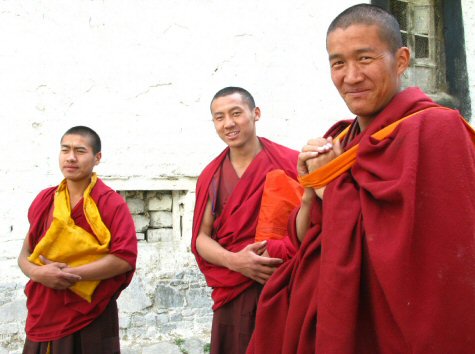
Photo by Karen Clapp
About the PANCHEN LAMAs TASHILHUMPU MONASTERY.
Tashilhunpo Monastery, founded in 1447 by the First Dalai Lama, is a historic and culturally important monastery next to Shigatse, the second-largest city in Tibet. Located on a hill in the center of the city.
Fortunately, although two-thirds of the buildings were destroyed during the Cultural Revolution, they were mainly the residences for the 4,000 monks and the monastery itself was not as extensively damaged as most other monasteries in Tibet, for it was the seat of the Panchen Lama who remained in Chinese-controlled territory.
In its prime, Tashilhunpo had over 4,000 monks and had four Tantric colleges each with its own Abbot. After the death of a Panchen Lama, these four abbots led the search for his infant incarnation and one of them always acted as a prime minister of Tsang under the control of the Dalai Lama in Lhasa.
In 1960, however, the monastery was disbanded by the Chinese army whilst the Panchen Lama was absent, although less damage was inflicted on the monastery than on most others around Tibet.
During the 1960s many senior lamas and monastics left Tibet and helped re-establish new monasteries in India, Nepal and Bhutan. The late Panchen Lama did not leave Tibet and consequently many of the senior lamas from Tashilhunpo Monastery remained inside Tibet. Therefore, while other monasteries-in-exile have expanded and developed under the guidance of senior lamas, Tashilhunpo has remained at a disadvantage, although in 1972 a new campus of Tashilhunpo Monastery was built by Tibetan exiles at a settlement in Bylakuppe, Karnātakā in southern India.
Since the early 1980s parts of the Tashilhunpo monastery have been open to the public and it is an important tourist attraction in Tibet today.
Interesting on the Tashilhunpo web stie:
AMBER ALERT - HELP FIND THE PANCHEN LAMA OF TIBET! http://www.tashilhunpo.org/amber-alert.htm
$33,290 REWARD FOR INFORMATION
A reward is being offered for information which results in outside contact with Gedun Choekyi Nyima, The Panchen Lama. The Panchen Lama was kidnapped by the Chinese government in 1995 and his wherabouts remain unknown.
This reward is serious. If you have information regarding the whereabouts of the Panchen Lama, Email or phone +(011) 91-8223-252601. Your name, and any information supplied, will remain confidential. $33,290 United States Dollars will be rendered to the person(s) who provides information resulting in outside contact with Gedun Choekyi Nyima.
Share this webpage with the media and with those you know, especially those in China and Tibet. For Chinese speaking people, please distribute the Chinese language version. Email if you're able to translate this into other languages.
Help increase the reward. Email your name, address, phone number and the amount in United States Dollars you can donate. Donations will be collected as soon as outside contact is established and verified. All funds will then be rewarded to the responsible person(s) who provided contact information.
More interesting reading here: http://www.tashilhunpo.org/monastery/panchen11.htm
In the last building is where the 5th through the 10th Panchen Lama are located. There was lots of construction going on to rebuild what the Red Army had demolished. What a shame that happened in the first place. The Chinese have realized that tourist $ are great so the Chinese put the Tibetans to work to rebuild the parts of monastery in front of the tomb that half the 5-10 lamas.
Tibetan women carrying loads:
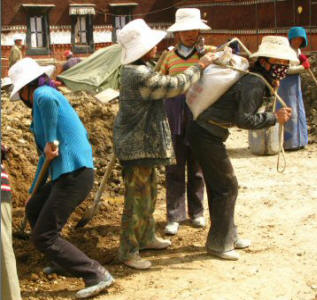
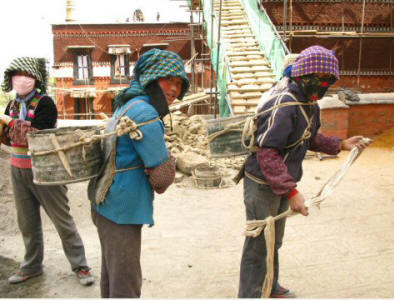
Photos by Karen Clapp
Check out the high, shaky, scaffolding that they have to climb with these heavy loads!!!
I wonder if the supervisor (carrying the stick) is Chinese?
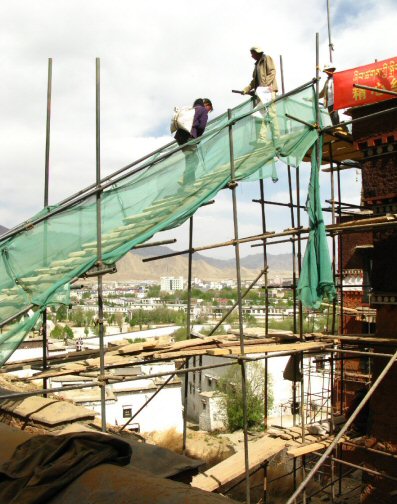
Photo by Karen Clapp
We (referring to us foreigners) have absolutely no idea what has been going on here. Watson has noticed cracked glass in store fronts maybe from stone throwing during uprisings last month when the country was closed perhaps? China does own and totally control this place. But the Tibetan people (if it is not a person begging) when you smile at them, they smile back and they smile with their eyes as well as their mouth. It looks genuine. But is ther also something else that they cant tell or show behind those eyes?
5:30 I walked a very very slow walk back to the room. That monastery tour about did me in. Its at the end of the street where our hotel is located. We walked up , up, and up. Then down, down, down. We are at almost 13,000 feet! Whew.
Hot shower!! Wash hair finally.
6:45 and MariJo finally returned. I was just going out to get some dinner. She bought the longest bunch prayer flags that she could find. She wrote her moms name on the first flag (which hangs the highest) and all her friends etc on the other flags.
The noodle soup was deelish. Lots of thin noodles. I would have like more broth, but it was fine. They also put a fried egg on top. Price was 8.40 Y so $1.00 USD. Not bad. Im tired.
Back to Top
Tuesday April 28 - Day 12 (Drive Day 4) XIGATSE to GYANTSE 55 miles (90 km)
This is what the itinerary said:
28 April - Xigatse Gyantse (3950m) : 90 km
Morning sightseeing to the PANCHEN LAMAs TASHILHUMPU MONASTERY. Drive to Gyantse and visit the Visit the KUMBUM STUPA & PHALKOR MONASTERY. Overnight at hotel.
We saw the monastery yesterday.
This is my account of the day:
Up at 7:40. My eyes were really bothering me last night I ended up just removing my contacts and threw them away. Ill wear my glasses for these final days at this high altitude. Im sure thats why my eyes were watering so much with the contacts. No dryness problems, for me. Were at 12.5 feet last night and were at 13 tonight. Whew. I think Im ready to be out of this altitude.
8:30 breakfast was boiled egg, a sliced bread roll, 2 small sweet muffins, sliced tomato and cucumber (pass).
Depart 9:30.
We have a short drive today. Guess we have a lot to see.
Get gas and at 9:50, Stop for petrol: Gas 33000 Sale, 57.39 a liter, 5.75 price.
Our convoy is on the road.
Marker by the road is "0008".
We are now driving along a beautiful tree lined (pix) street with mountains all around (of course).
10:00 am at 0046 marker. I took a pix of me with the driver and a pix of our guide. The name of our guide is "Lha dup".
10:05 Passing Shaula Monastery at marker 0020.
10:50 GPS reading at marker 0060.
29 04.872N, 089 17.854E, 3913 meters, Accuracy 9 meters
12,838 feet
We stopped at place where they grind "millet". They are making tsampa and maybe making an alcohol drink from it.
There was a nice (meaning not smelly) outhouse.
From markers 70 to 90 there is lots activity in the fields around here. Tilling the soil with a mule and hoe. Dark soil underneath is pulled up to the surface and exposed.
Marker 90 driver points and says something. There is a building on top of tall hill.
?Chode Monastery
Arrive in GYANTSE.
This is the fourth largest town in Tibet (after Lhasa, Shigatse and Chamdo). Gyantse's population is about 8,000 people. It is 3,977 metres (13,050 ft) above sea level, and is located 254 km southwest of Lhasa in the fertile plain of the Nyang Chu valley and on the Friendship Highway, which connects Kathmandu, Nepal to Lhasa, Tibet.
We turn on Hero South Road.
This photo shows the traffic light on the road. Yeah, like you really need that when there are NO CARS!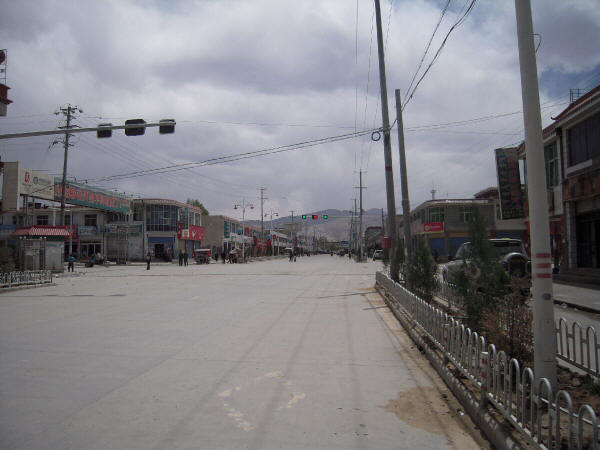
Every sign was displayed in 3 languages: Tibetan, Chinese and English
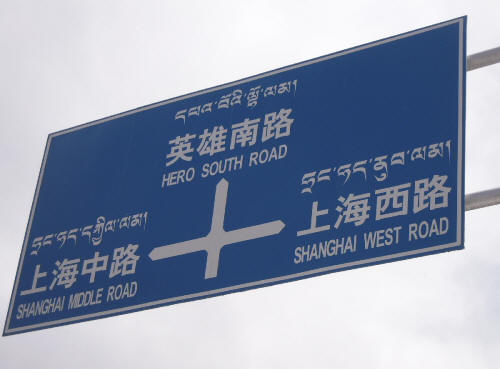
11:45 and we are at the hotel in the room. We are in the Jian Zang (Gyantsen) Hotel. Two Stars.
Address: No. 14, South Hero Road, Gyantse, Tibet China. TEL: 0086892. Complain Tel: 13908920205. Email: jianzanghotel@yahoo.com.cn
(Im not kidding, the business card for the hotel really had a "Complain Tel" number!)
This is same hotel that is featured in the BBC documentary "A Year in Tibet". It focuses on the lives of ordinary Tibetans living in this city. The hotel has been awarded a two-star rating, but the manager of the hotel thinks that he looses business because of the (high) rating. He solicits the tourism bureau for permission to not acknowledge the 2-star rating.
Episode 1 of 6 http://www.youtube.com/watch?v=MhW4dNISoXs
Episode 2 of 6 http://www.youtube.com/watch?v=ywR7bGFiDLo&feature=related
Episode 3 of 6 http://www.youtube.com/watch?v=koEsVphftr0&feature=related
Im sharing a room with MariJo again. The room is nice, but MariJos opinion is that it is dank, dark and cold. Yes, it was cold. She went to the front desk and guide to ask if we could have a different room that got more sun. Whatever. I was OK with the room. It had two beds and an attached bathroom. So after MariJo (the person with the least amount of luggage) realized that we were not going to move (the person with the most luggage), we found that the toilet doesnt work. Shes a great roommate and went back to the front desk to ask someone to come fix it. They did.
We didn't have to meet again until 3 pm so we had 3 hours to eat lunch and discover the town.
I wandered outside to see what was going on in the town. At the end of the street, there was a festival. A stage and dancers. I wonder what the sign says?
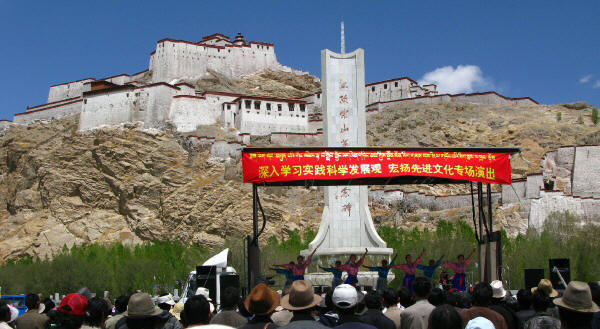
Photo by Karen Clapp
I'm guessing that this sign says: "Big Brother is watching you."
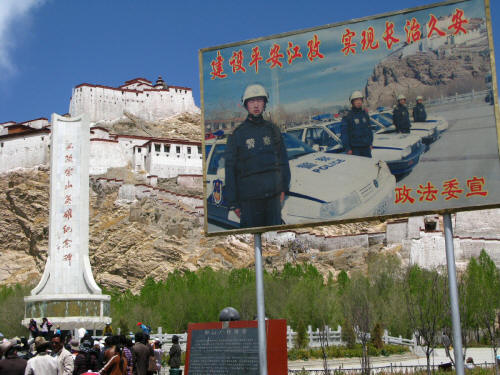
Photo by Karen Clapp
Note the fort, or fortress, or "dzong" which means "Bhutanese fort" on the hill is not the monastery. The building is mostly still in ruins and there is an "Anti-British Imperialism Museum" in the fort. It is said that this museum gives the Chinese version of the 1904 British invasion. Reminds me of the "American War" museum in Saigon that gives the Vietnamese version of the US invasion. We did not visit the fort/museum. Thank goodness, that looks high with many steps!
1:30 - After the festival ended, I walked back down South Hero road on the other side of the street as our hotel. I was looking for a place to eat lunch and a very enthusiastic lady called me into her restaurant.
"Zxuang Yuan Restaurant", also written "The Restaurant of Zhuang Yuan".
Address: Ying Xiong nan Lu Road in Gyantse Tibet, China.
There was no one else in the place. She started showing me notebooks of people who had written reviews after eating there. She found the English reviews and had me read them. She open the refridgerator and showed me all the fresh vegetables. Then she pulled out some photos of cooking sweet and sour chicken and mushroom chicken. I was thinking about getting my safe, usual lunch of some noodle soup, but she convinced me to order the sweet and sour chicken with no bones (45) (with bones was 35). Rice was 5 and coke was 7 Yuan.
So I'm reading about the history of the place - the restaurant was established in 1988 on S. Hero Road. The cook is from Cheng Du China. I read several reviews that the banana dipped in caramel is delicious. The menu was very extensive, including Mashed Potatos! Some other things on the menu: Beef noodle soup (20), chicken noodle soup (25).
I hear her calling and appears making motions like she is taking a photo. I realize that she wants me come back to the kitchen with my camera. She showed me the sauce that she was cooking and the fire that appeared when the chicken was cooked. It was quite a show.
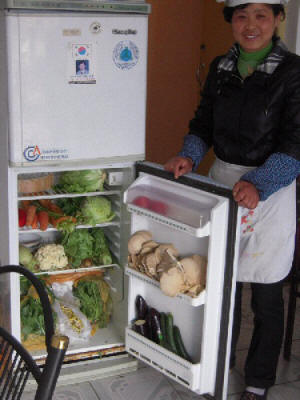
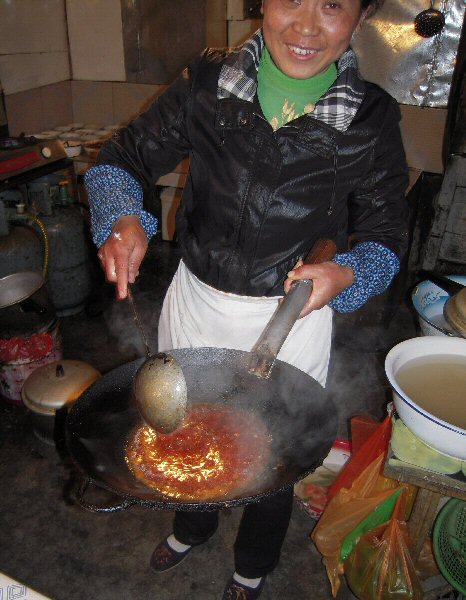
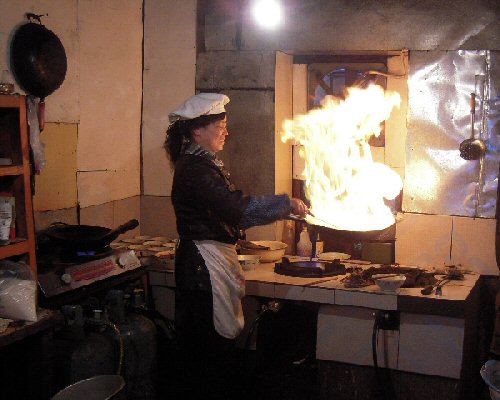
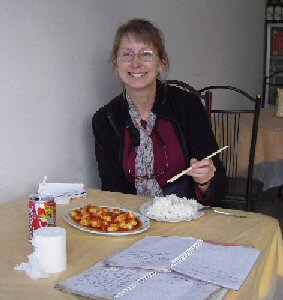
I couldn't believe the amount of food that she put down in front of me. This was Day 13 of my trip and I hadn't been eating very much for then entire trip.
I absolutely Loved the curry dishes in Sri Lanka, but did not find anything that I liked in India yet (different curry?). I have never liked Chinese food and the altitude was really making me loose my appetite.
So I take a bite of this sweet and sour chicken and realize that it is the best that I have ever eaten. I actually cleaned the plate.
I would definitely recommend that you try this place if you visit Gyantse.
The cook also said that if you went across the street and purchased anything from the market, she would make you a good meal. Here's a photo of the market:
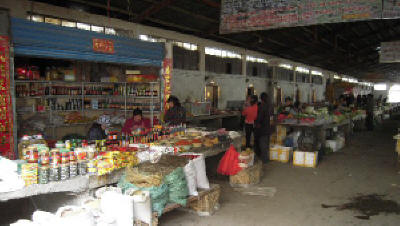
At 3 pm, our group met in the courtyard of the hotel. The guide asked if everyone was OK to walk to the monastery. Hmmm... if we were headed to that building at the top of that hill, I mean mountain, then a ride sounds like a good idea. But we are on our 4th day at almost 13,000 feet, so we should we should be acclimated, so nobody accepted the invitation and we started walking to the Phalkor Monastery.
We walked a short distance down to the end of the street that our hotel was on (South Hero Road), turned left, walked a bit more, then turned right and walked down a residential street. That was a most interesting walk. Everyone seems to own a cow or a sheep....
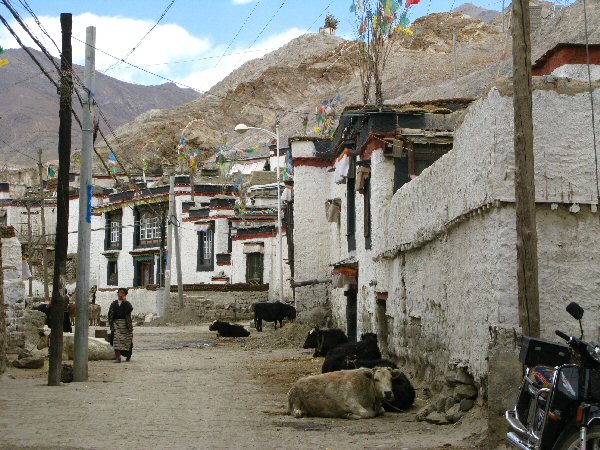
Photo by Karen Clapp
Some other sites on the walk down the street:
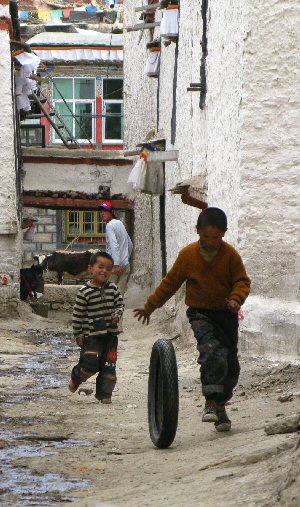
Photo by Karen Clapp
| 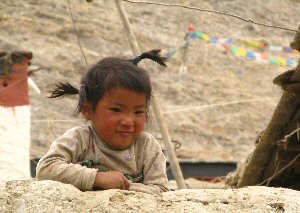
Photo by Karen Clapp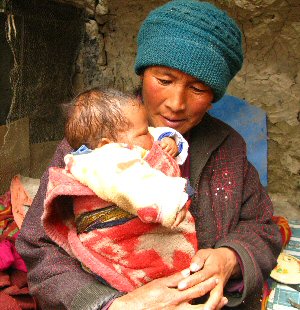
Photo by Karen Clapp
|
Along the walk, Olivia, Sara, Alexandra, and Watson are invited into a home for tea.
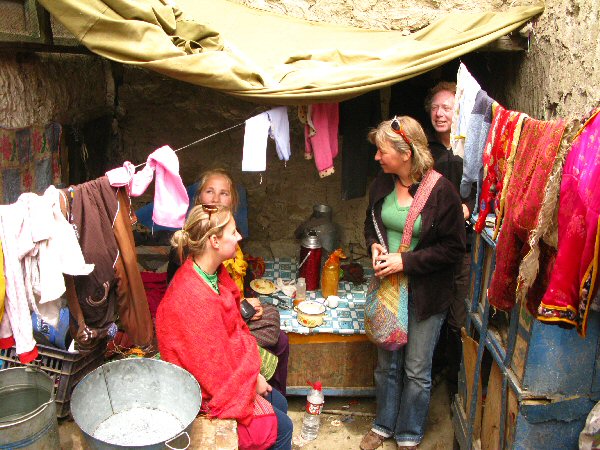
Photo by Karen Clapp
We finally arrive at the monastery.
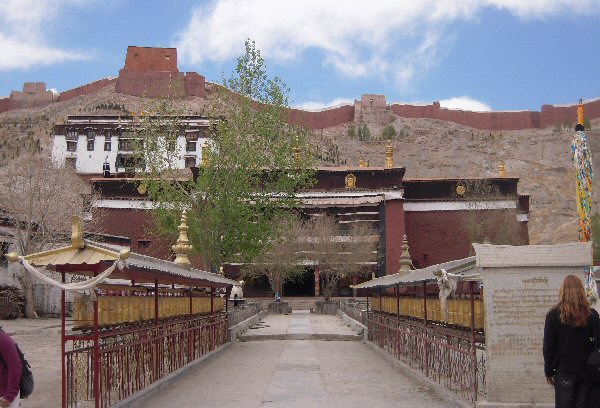
About the KUMBUM STUPA & PHALKOR MONASTERY
Gyantse is notable for its magnificent tiered Kumbum (literally, '100,000 images') of the Palcho Monastery, the largest chörten (After "stupa," "chorten" is the most commonly-encountered English term.) in Tibet. The Kumbum was commissioned by a Gyantse prince in 1427 and was an important centre of the Sakya school of Tibetan Buddhism. This religious structure
contains 77 chapels in its six floors, and is illustrated with over 100,000 murals, many showing a strong Nepali influence which have survived pretty well intact. The back of the ticket said "This tashe multi-door religious structure is 32.4 meters (106 feet) tall and is said to have 108 cells containing veneralle mural paintings and holy images to 100,000"
They are the last of this type in Tibet. Many of the restored clay statues are of less artistry than the destroyed originals - but they are still spectacular.
The town was nearly destroyed in 1954 and was largely emptied of people by the Chinese in 1959. During the Cultural Revolution the fort, the monastery and Kumbum were ransacked or destroyed.
The main building of the Pelkor Chode or Palcho Monastery and the Kumbum have been largely restored.
This is my decipher of the scribbles that I made during our visit:
Built in 1418.
There are 4 Sects (is that the right word?) of Buddha: north, south, east, west
There three of five five Wisdom Buddhas of the Vajrayana tradition displayed:
Ratnasambhata
Akshobhya
Amoghasiddhi
In the second building The 11 Panchen Lama
In the room on the right - these Buddhas all with different poses with the hands.
Erdeni
Atishai Dipamkara Shri Juana
Karmalahila
The Abbot (Shantarakshita)
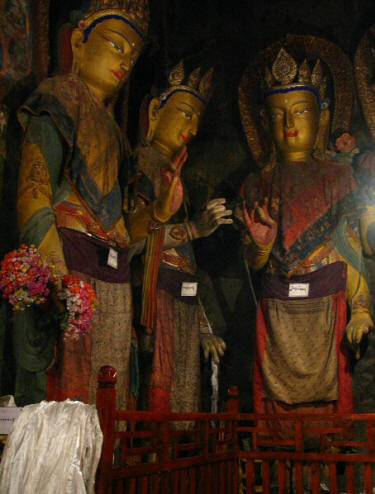
Photo by Karen Clapp
Songtsen Gampo
Trigong Detsen
Tri Ralpanchen
And that is Sara and Watson also in the photo!
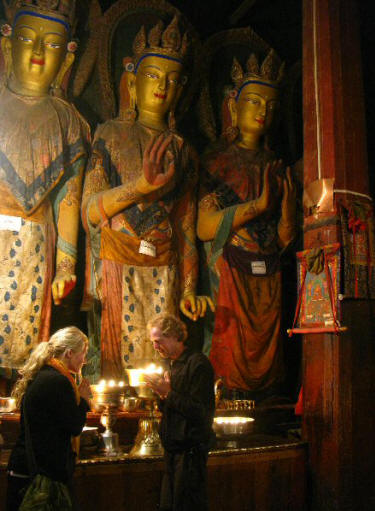
Photo by Karen Clapp
There are many many prayer books. Stacked along an entire wall of the cathedral as high as the ceiling. I didn't see a ladder, how to they get the ones at the top? Climb the bookcase?
In this photo, new prayer books are on the left and the old ones are on the right.
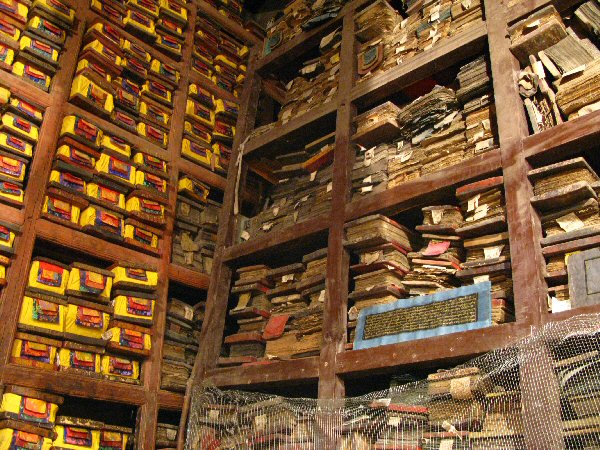
There is a display of statues of Buddhas for the kings of Tibet. "Metria" is behind the great king of Tibet.
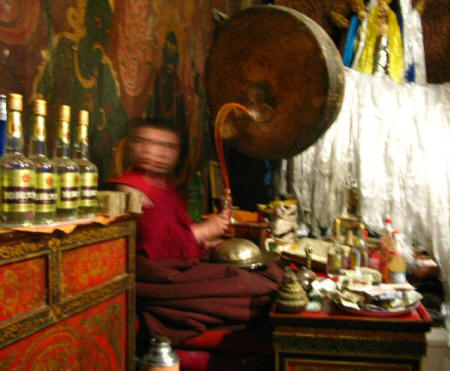
In the room on the left side there are scary masks everywhere. There is monk sitting in this room. See picture on the right --->
The monk is banging on a drum and chanting. He is drinking what looks like a clear liquid. (See the bottles in the picture). Something tells me that he is not drinking water.
There are bottles of clear liquid lined up in front of him. Looks like some type of alcohol perhaps? Are they for sale?
Thanks to Huup for being here with a guide book so we knew what we were looking at!
We are in the Protector Chapel. There are pictures on the wall that show sky burials they lay out the dead people very high and the vultures eat them ?!. The mask represent bad deities.
Two Tibetan women in this chapel stopped and looked at my writing and looked very curious. She pointed to and touched my right hand. I moved the pen to that hand and made a motion that I cant write with that hand. They seemed amazed (or bothered perhaps) that I was writing with my left hand.
Tibetans are going into the same rooms that we enter. They carry a thermos of hot wax? No, it is Yak butter. They drizzle a little bit on butter candle in the temple to keep it lit.
Very cute kids.
Room on the right:
Vijaya many arms holding things.
Amitayus Buddha of longevity. He holds a bouquet of flowers.
White Tara middle finger is touching his thumb.
Unbelievable. There is another tour group here visiting the monastery. They have not even entered this spectacular building. They are all standing in front of it discussing the itinerary with the guide instead of going inside the temple. Seems they though they would be going to a typical Tibetan home for a meal and the guide didnt know anything about that. Geez.
The KUMBUM STUPA
This is a photo of Karen Clapp. In the background is he town of Gyantse, the Tashilhumpu monastery, and The Stupa. Karen took some great pictures of this trip. I had an empty 8 gig thumb drive and Karen was very nice to fill it with a copy of her wonderful photos. Thanks Karen!
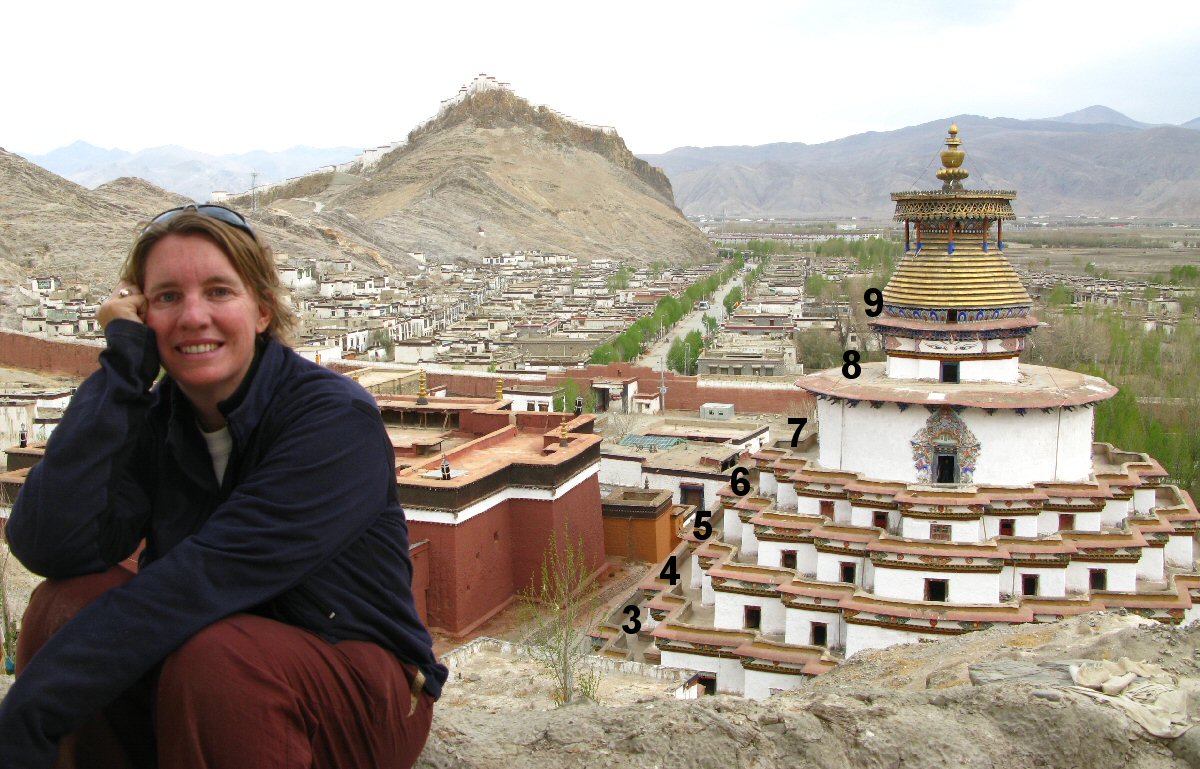
Photo of Karen ClappThere are 9 levels in The Stupa and 77 chapels. In the picture above, I added numbers to show the levels. You can also see the doors to the chapels on each level. You start at the bottom level and work your way up the stupa. The Tibetans go into every single room! Some leave money. Some have with prayer wheels that they run along the wall.
Huup had a guide book that said to look for a hidden staircase to the top level. We found the steps and ladder. I wish we had brought a torch (flashlight) because it was very dark climbing. Here I am standing on Level 8 looking at the eyes on top.
Compare the size of the eyes in this photo,
to the size of the eyes in the photo above on Level 8. That's a big stupa!
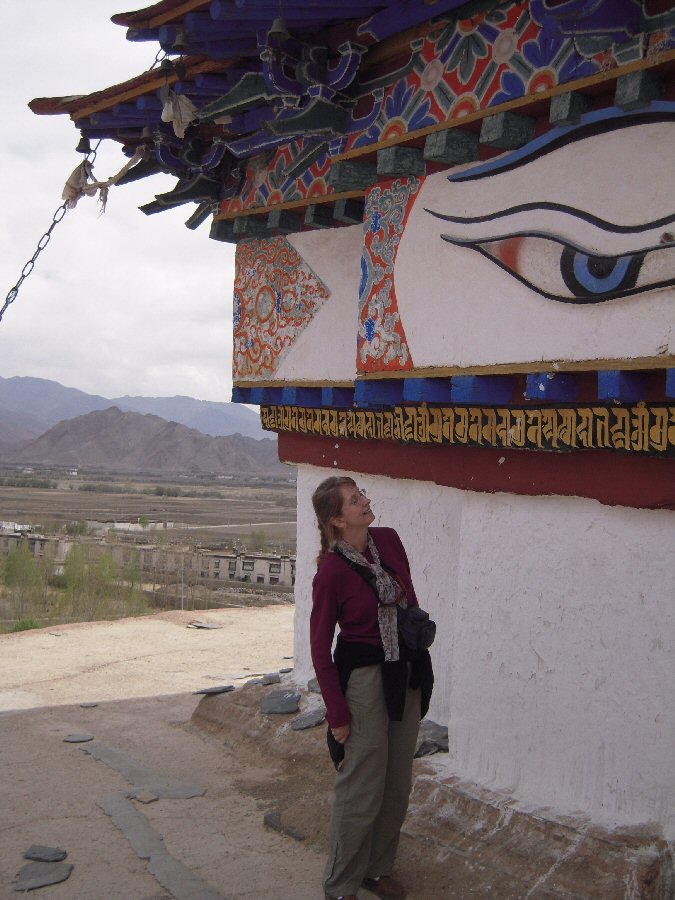
Photo by Huup
This photo shows how you walk around on each level and the doors to the chapels
.JPG)
This is how you get up to the next level. There are stairs at the lower levels, and ladders further up.
.JPG)
159.JPG) Photo by Karen Clapp
Photo by Karen Clapp
Kumbum literally means "100,000 images". Many of these images and statues were destroyed by the Red Army. They don't believe in religion, but they did realize the monetary value so they Buddhas were rebuilt. I think I remember seeing only 2 closed rooms. Here's a sample of what you see in the chapels:
.JPG)
.JPG)
.JPG)
.JPG)
.JPG)
.JPG)
.JPG)
.JPG)
.JPG)
.JPG)
.JPG)
.JPG)
Anyway, you get the idea about what is displayed in the 77 chapels.
This is Watson pondering one of the images of his religious belief.
142.JPG)
Photo by Karen Clapp
This would be a good place to interject the "Watson the Diplomat" story. I'm
not sure exactly when it happened, but this is what happened:At an army checkpoint that we stopped at, all six of our vehicles cooperatively lined up at stopped at the barrier crossing the road. The guide got out of the front car to the police officer. The officer said that we would have to wait 6 hours because of road construction. Our guide appeared submit to the request and say "OK" and walks away. The Guide tells the people in the car. That news does not sound good. The guide did not appear to want to talk to, or negotiate with the officer. So, Watson was going to take action. Watson, with the guide, went to the officer. Watson explained that we had sick people in the car (sick from the altitude). "We do not have enough food and water to stay here for six hours. " He even went so far as to say "If these people die, then you will be responsible". The officer responded (he understood English !?!). Then the officer said that he would see what he could do. He made a phone call and came back to say that we could pass in 30 minutes. Yeah Watson!
After the monastery tour and stupa climb, I was so tired. I walked slowly back to the hotel with Jon and Ali. Yeah! MariJo got our toilet fixed. Shes a good roomate. Its freezing in the room. No sun. I rested for an hour.
For dinner tonight, a bunch of us met around 7 pm. 6 of us ended up going to the restaurant where I ate lunch
, and some others went to the other place where you point to the different foods in the bowls and they stir fry it. I was still sated with my big lunch chicken dish, so I just got a dessert for "dinner". Banana caramel (35) and Flower Tea yum! (7) = 43 yuan.After dinner, I took a hot shower, washed my hair. Got to sleep around 10:30.
Whew, what an awesome day!
Back to Top
Wednesday April 29 - Day 13 (Drive Day 5) GYANTSE to LHASA 162 miles (261 km)
This is what the itinerary said:
29 April - Gyantse Lhasa (3650m) : 261 km
Full day picturesque drive crossing over KAROLA 16,427 feet (5010 m), KAMBALA 15,728 feet (4794 m), coloful YAMDROK LAKE and the Tibetan lifeline river and the Tibetan lifeline river BRAHMAPUTRA (YARLUNG TSANGPO). Overnight at hotel.
This is my account of the day:
Up before breakfast. MariJo offered me some of her delicious instant coffee. I added my Splenda sweetner and we had a very nice morning wake up. Thanks Mar
iJo!Breakfast at 7:30. The breakfast room this morning was the nicest so far. There were 3 big tables with turning lazy susan in the middle. We got 2 pieces of the traditional round Tibetan bread and a fried egg. They were only serving tea so Im glad that I already had some coffee.
The rooms were very cold at night, but we had very thick blankets and a duvet cover to keep us warm in bed. Oh yeah, Im not going to mention what Mar
iJo found in her bed this morning.enough about that.Its 8:30 and the convoy is on the road again. We have over 5 hours of driving today and three mountain passes.
9 am marker by the road says "171".
I always laugh when I remember Peter and Huub practicing their Tibetan in the back seat. Its admirable that they are very diligent about learning and remembering what to say and how to say it in the other language. But the phrase they were practicing how to say in Tibetan is "I need to rent a Yak". Excuse me?!? When would you ever need to use that phrase??? Oh yeah, maybe when you are trekking you may need to rent a Yak to help carry the stuff. It just strikes me as quite humorous needing to rent a Yak. It still makes me laugh even as I type this.
Man are we going through SOB turns in the road now! Its a good road with guard rails, but the "Slide Over Baby" (SOB) whips around the hair pins tossle you in the car.
Marker 164. We see a BIG lake. There is a Dam at the beginning of it.
Simila (?) Pass with the reservoir. They have dammed it for hydro electric power.
Colorful YAMDROK LAKE - One of the three largest sacred lakes in Tibet. It is over 72 km (45 miles) long. The lake is surrounded by many snow-capped mountains and is fed by numerous small streams. The lake does have an outlet stream at its far western end.
According to local mythology, Yamdok Yumtso lake is the transformation of a goddess.
Yamdrok Lake, has a power station that was completed and dedicated in 1996 near the small village of Pai-Ti at the lakes western end. This power station is the largest in Tibet.
Around 90 km to the west of the lake lies the Tibetan town of Gyantse and Lhasa is a hundred km to the northwest of the lake.
So we've driven 90 km to and we have 100 more to go....
GPS Reading at 9:19 am
28 50.067N, 089 51.335E, 4371 meters, Accuracy 8 meters
14,340 feet
.JPG)
14,360 feet and SWSG (So far so good)!
.JPG)
Marker 161There are lots of power lines draped over this valley.
Green fields here and donkey and horse carts on the road.
Marker 129 we are seeing beautiful snow capped mountains.
10 am photo stop of goats (?) or some animal at marker 125.
11:10 GPS reading.
28 53.937N, 090 09.818E, 4989 meters, Accuracy 14 meters
16,383 feet
We are at the Kharola Glacier. About marker 111. Hmmm, our reading said 4989 meters, but the sign says "5560M". I bet that means the top of the glacier.
.JPG)
It looked like some people lived up here at the glacier. No doubt, trying to make money selling things to tourists. Watch out the for fake Amber (with the fossilized "dead bug")!
The children were very nice. They realized they weren't getting any money or candy, but I have learned to bring stickers with me on my trips. The kids put the butterfly stickers on their foreheads:
.JPG)
.JPG)
They had the cleanest bathrooms here at the glacier!
The ladies room had 8 "stalls".
When you are using the "toilet" be careful where you put your camera. I heard someone's camera fell down the hole !?!?! Yukkkkkkyyyy... (visions of Slumdog Millionaire - just kidding, it wasn't that bad). A million thanks MariJo for retreiving it !
10:45 driver is saying "Brahmaputra River" I think
Stop for lunch. The group split up so lunch would be faster 6 of us went upstairs . Vegetable soup, sweet milk tea. Yum.
A Snickers bar was 10 Yuan.
11:50 back on the road after lunch.
At the very end of the lake, we drove around the tip of the lake on a dirt road. Now the lake is on our right. Beautiful blue green color, clear water.
GPS Reading
29 11.268N, 090 34.751E, 4456 meters, Accuracy 22 meters
14,619 feet
Yamdrok Lake picture stop. We stopped about 10 minutes.
046.JPG) | Our six drivers and the "guide":
.JPG) |
The beautiful lake:
.JPG)
Photo by Suzanna
048.JPG)
Photo by Karen Clapp
.JPG)
Photo by Suzanna
We did another picture stop at KAMBALA Pass at marker 34 on highway.
GPS Reading 1:21 pm.
29 11.681N, 090 37.118E, 4787 meters, Accuracy 8 meters
15,705 feet
Hmmm, our reading said 4787 meters, but the itinerary said KAMBALA Pass 4794 m. I'd say that is close enough.
In the photo below, I added the arrow to point out the road that we drove on to decend into Lhasa. In this photo you can also see the and the Tibetan lifeline river BRAHMAPUTRA (YARLUNG TSANGPO).
A trans-boundary river and one of the major rivers of Asia. About 1,800 miles (2,900 km) long. The average depth of river is 124 feet (38 m) and maximum depth is 380 feet (120 m). In Bangladesh the river merges with the Ganges and splits into two: the Hugli and Padma River. When it merges with the Ganges it forms the world's largest delta, the Sunderbans- known for tigers, crocodiles and mangroves. While most Indian and Bangladeshi rivers bear female names, this river has a rare male name, as it means "son of Brahma in Sanskit (putra means "son").
059.JPG)
Photo by Karen Clapp
Here are two modes of transportation in Tibet. This is what we refer to as a "Show Yak". You can pay to ride it or get your photo taken on it.
.JPG)
1:50 Very winding road to decend:
.JPG)
2 pm cross a bridge over the lake. We are following a road sign to turn left for Lhasa
Now we are in a valley. Tree-lined street with mountains all around (of course).
It has been a very nice temperature all day. At the highest pass I only needed a sweater. Calm winds also.
At 2:20? we passed an airport turn off.
.JPG) 2:50 pix stop. Budd
2:50 pix stop. Budd
ha from 11th Century Shackyatuba.
Here are my wonderful, wonderful, car-mates: Mille, Peter, me, and Huub. It was such a pleasure to spend four days in the car with them. We shared a few good laughs. Remember when the drivers cell phone ring would ring (a lot)? Sometimes he would not answer it and we had to listen to the whole song:
Once again Im longing
For your loving touch
Picturing you and me
Im missing you so much
I think Peter and Mille were continuing on to travel for four (?) months.
3 pm and were back on the road. Maybe an hour more to drive. There is a lot more traffic in both directions.
At 3:15 I see a "Welcome to Lhasa" sign.
This sign is too funny: "The developing zone is very promising".
I see Ford, Audi, Toyota, Nissan, VW dealerships.
At 3:30 I get my first Potala sighting.
At 3:50 we are all checked into our rooms.
Flora Hotel
http://florahtl.piczo.com florahtl@hotmail.comHobaling Road Mosque, Lhasa, Tibet, China
Tel: 0086-891-6324491,6273177, 6277022
The water heater pot in my room looks like it had not been used a long time... I wonder if these room were used when the country was closed in February and March.
I turned on the television to see if I got any English channels. 27, 31, and 49 were Chinese with some English.
I turned on my cell phone, and it worked in Lhasa! Called Dad. The call was almost 4 minutes at $3.49 a minute the cost adds up.
I met a group for dinner at 7 in the lobby. Some young school girls walked with us to find the restaurant recommended by the front desk. She asked me where I was from. I said "America" and her eyes got big because they are not accustomed to getting visitor from the USA. (We don't travel much with this recession.) Anyway, she looks up at me and says "Obama." I was impressed. "Yes, he is our new president" I respond. Smart kid.
We couldnt find the restaurant, so we walked into a different place. They led us a nice room in the back. You could tell they were scrambling to find a picture menu with English. We waited a little while and finally one menu appeared. Yeow! Such high prices! The menu didnt seem to match anything on the chalk board in front of the restaurant. We left and found another great place. We sat on the second floor overlooking the beautiful square. The red arrow below shows the location. Photo was taken from the roof of the Jokhang - notice the Potala in the distance.
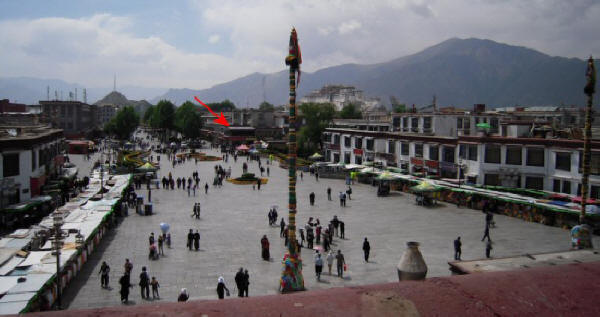
Everyone has been raving about "mo mos" so I finally tried them. I got fried vegetable mo mo's and Sara got steamed for 18 yuan. I had one of her steamed mo mo and wished I had not gotten the fried. I also got a Banana Lassi for 9. Deelish. This has been such a perfect trip.
Back to Top
Thursday April 30 - Day 14 - In LHASA
This is what the itinerary said:
30 April and 01 May In Lhasa (3650m)
Two full days of sighseeing tour to Lhasa including JOKHANG TEMPLE , BARKHOR BAZAAR, POTALA PALACE, DREPUNG & SERA MONASTERIES.
I did not get my 7:30 am wake up call. Instead some very loud birds woke me up. I guess that is better then waking up to barking dogs. But there was no electricity. I dressed and went downstairs, someone was sleeping in the lobby (the son perhaps?) and the father was just arriving downstairs. He came upstairs with me to the 3rd floor. He flipped a breaker then he went back downstairs. I went to my room, and still no electricity. I went downstairs again. He came back up, did something and I had a light in the bathroom finally. But it only lasted about 30 minutes. And no power again. Thats ok for now, but I will probably need it tonight.
Breakfast 8:30. Our individual orders for breakfast were recorded on a piece of paper where you check off what you want. Hard boiled egg, soft boiled egg, or fried egg. Tibetan bread or toast, jam, butter. I thought it was very good. I'm loving the toast. The bread is sweet, almost like hint of coconut flavor. I accustomed to eating (lots of) sugar. Other people seems to prefer the plain-tasting Tibetan bread. I know Im looking forward to breakfast tomorrow, but I heard some say it was the worst ever.
This is story that heard at the breakfast table: someone saw men in uniform taking 2 tibetan women (who were holding small children) into a truck. The women did not want to go.
Depart 9:30 for the tour.
Rules: No liquids, no lighters allowed in the Potala and we need to have our passport and visa (we did not have to show it though). Do not take any photos of army or police.
If you get lost, meet at the bus station at 1:00 pm.
GPS Reading at 9:30 am at the Potala Palace, I mean the Potala Museum.
29 39.043N, 091 08.268E, 3672 meters, Accuracy 17 meters
12,047 feet
I also read
29 39.044N, 091 08.268E, 3668 meters, Accuracy 17 meters
12,034 feet
About the POTALA PALACE
The Potala Palace was the chief residence of the Dalai Lama until the 14th Dalai Lama fled to Dharamsala, India, after an invasion and failed uprising in 1959. Today the Potala Palace has been converted into a museum by the Chinese.
The building measures 1312 feet (400 metres) east-west and 1148 feet (350 metres) north-south, with sloping stone walls averaging 10 to 16 feet (3 to 5 m). thick. More than 16 ft thick at the base, and with copper poured into the foundations to help proof it against earthquakes.
Thirteen stories of buildings containing over 1,000 rooms, 10,000 shrines and about 200,000 statues soar 117 metres (384 ft) on top of Marpo Ri, the "Red Hill", rising more than 300 m (about 1,000 ft) in total above the valley floor.
Interior Tour of the Potala Palace (Tibet) http://www.100gogo.com/tibet/pa1.htm
So here is one of my pictures of the Palace.
I actually took this photo in 2002 in Orlando, Florida at Splendid China. It was 76 acre park with exhibits replicating Chinese landmarks in miniature, including the Great Wall and the Imperial Palace in the Forbidden City. There are knee-high buildings, bridges, and temples. The Potala Palace is a featured replica in the park.
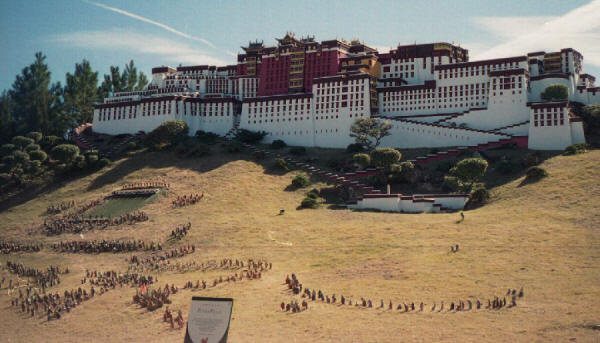
So compare the photo above, to the real palace below. This where the Dalai Lama, Tibet's true leader lived until he fled the Chinese occupation of Tibet in 1959.
.JPG)
My visit to The Potala Museum:
.JPG)
We stood in line less than ten minutes. You have to put your stuff through an x-ray machine and walk through a metal detector.
10:05 we enter the Potala Palace, I mean the Potala Museum.
Walk up steps, up, up, up.
At the top of the steps, you buy you ticket to enter. It is a very fancy 3-dimensional photo of the palace. I think is 100 Yuan.
This is the door that you go through to enter the museum. At 10:35 are we're inside so no more pictures.
.JPG)
After you go through these doors, there are "golden handprints" on the left wall. Then you go up some stairs, then you are in a big 1,600 meters square pavillion the "Deyanshan" (in Tibetan "East Celebrate Square").
3 wood stairways to the "White Palace". The middle stairs was only used by the Dalai Lama. White Palace is where Dalai Lama lived. It also administration offices and meeting hall. Many beautiful wall paintings.
White Palace top floor - the interior palace of Dalai Lama. There are East and West Sunlight Halls. The South side had a tall, tall window where the sun shines in, thusly named "Sunlight Hall". It was very luxurious.
The "Red Palace" contains the Dalai Lamas' tomb pyramids, halls, and Buddhist Temples. Many treasures including 8 tomb stupas of Dalai Lamas: Dalai V, Dalai VII, VIII, IX, X, XI, XII, and Dalai XIII .
You are shuffled through one room at a time. It is very planned out.
Room 021 Cham Khang. 8th Dali Lama. "Jamkang Maitreya Budd
ha Chapel"Room 020 Loilang Khang. 7th Dali Lama room. Huge big golden mandala in this room.
Room 019 So Sum Namgyal. Collection of
Buddhas from the 4th century. Rooms also has book for chanting. The Confession Buddha.Room 018 Cheme Dedan Khil (The Eternal Happiness). This is the Center of the Red Palace. It was built for the 8th Dalai Lama.
Wisdom Budd
ha is red, Confession Buddha is white, Energy (power) Buddha is blackRoom 017 Lama Lhakang
016 Serdhang tashi Waiker Khan. Tomb of the 8th Dalai Lama: The Gelek Sibar. He build the Summer Palace in his lifetime. This is the "best one gold (not bronze) and turquioise Phagpa Lhakang (The Enlightentened Chapel).
013 SerdSasum. Hgonga Khang. 9th Dalai Lama Tomb. He dies when he was 11 years ond. The tomb is very tall, gold with turquise stones.
Walk a bit
012 Dukhor Lhakang The Wheel of the Time Chapel". Bronze
011 Thubwang Lhakang was closed
010 was closed
009 Zegya Lhakeng. Zegya means "100 days of history of the Budd
ha". Each statue has a story.Before they built the red palace, the king studied here. It was built in the 7th Century. There is a statue of the king, his wife, and sons in this room. It was cave, and it became a building.
"The Chogyal Drupuk" means The Cave of the Religious King.
The wood stove was used by the princess of China.
Kunsang Jedrokang "Good to All Chapel"
Room 006 Lima Lhakang The Alloy Steel Chapel. . Collections of Budd
has white, blue and black. All colors.Downstairs, down more to the Big Assembly Hall. They are cleaning the scriptures here. They do that once year.
Room 004 Lamrim Lhakang The Path of Enlightenment". Walk into Rigzin Lhakeng "The Knowledge Holder Chapel".
The
Buddha here taught the oldest sect of Buddhism. He was 1st of the seven monks in Tibet.What differentiates a "Palace" vs. "Monastery" . A monastery needs three things: monks, praying stautes, and ? to quality as a monastery.
There are 8 more manifestations of Budd
ha in this room.Room 002 Serdhong Zamling Gyenji Khang (Gyanchilc) . 5th Dalie Lama tomb and Stupa is in this room.
126 m high, 7.6 at the base. 3721 kg of gold and 10,000 precious stones. WOW!
Also 10th Dalai Tomb with the stupa on top.
Room 001 I cant read. 11th Dalai Lama Tomb. Trungrab Lhakang. "The Chapel of the Holy Born". 1th to 4th Dalai Lama. The 3rd Dalai Lama was mongolian. He was the only one that was from Mongolia.
11:20 exit. We can take pictures again.
We had to go up stairs to get up to the palace, but after you exit, you walk down ramps. Down, down to a parking area surrounded by shops. Connie, Sven and I could not find the bus in the parking lot, so I had an hour and a half (until 1) to wait and write.
I was in the palace about 1.5 hours. Tourist season starts tomorrow (May 1). You can only be in the Potala for one hour maximum.
.JPG) I walked across the street to get some photos of the palace. There were people praying in front of the Potala. They lay flat on their stomach and reach out to the building, then get up, pray, and repeat.
I walked across the street to get some photos of the palace. There were people praying in front of the Potala. They lay flat on their stomach and reach out to the building, then get up, pray, and repeat.
There is a man looking over me watching me write this right now. OK, now Im collecting a crowd. There are many nice people looking at me writing. An older lady makes a comment to some others standing around. She is spinning her prayer wheel. She sat down right next to me, very close, touching my right arm. Still spinning her wheel.
12:20 the older lady is sitting right next to me chanting and spinning her wheel. I moved over a little bit, but its a very small bench. Two young girls stopped to look at me write.
Our guide was Not Good at the palace. Group broke apart. I ended up with an English speaking guide with a man and another woman. It was a lot better then our guide. I hope I can find our group later. Now there is quite a group watching, so I need to keep writing
I gave my pad to the young girl gazing at me. She took my pen (in her right hand) and wrote "My name is Kunsang". She asked if I knew about her home town "Ngari" she wrote the name of the town in my book. Its in "West Tibet" she said. Her homeland. I could tell she was missing the place and very homesick to go back.
Another photo. The birds are free, but are the people?
.JPG)
The back of the palace:
.JPG) | The side of the palace: .JPG)
|
1 pm and we are back on the bus. We stopped at Bank of China so people could exchange money. A sign in the bank said "If amount is less than RMB 20,000, please use ATM." Several people had no problems using the ATM.
Back to hotel at 1:30. Watson and I got a really good bowl of noodle soup and sweet milk tea at the hotel restaurant. 10 yuan. Yum.
I went up to my room to lay down for a minute. I had electricity, but still no light in the bathroom. I'll deal with that later.
3 pm, no make that 2:30 pm depart for our tour of the Sera Monastery.
If you get lost (which I have found really means "if you find another English speaking guide that you want to follow around), then meet at 5:30 pm by the bus.
Here is the back of the ticket to get in. I included
it to show how everything (including road signs) is always written in 3 languages: Tibetan, Chinese, and English..jpg)
Some information from: http://en.wikipedia.org/wiki/Sera_Monastery
This is original Sera monastery, about 5 km north of the Jokang in Lhasa. After the Chinese took control of Tibet in 1959, it was reconstituted in Bylakuppe[1], India, near Mysore. The original in Tibet continues as a working monastery.
Sera Monastery at the foot of Tatipu Hill is located in the northern suburb of Lhasa City. It is one of three famous monasteries in Lhasa along with the Drepung Monastery and the Ganden Monastery. The Sera Monastery is dedicated to the Gelugpa or Yellow Hat Sect.
Built the monastery in 1419 during the Ming Dynasty (1368-1644). The monastery was named Sera which means "wild rose" in the Tibetan language, because the hill behind it was covered with wild roses in bloom when the monastery was built.
The monastery is magnificent and covers an area of 114,946 square meters (28 acres). Its main buildings are the Coqen Hall, Zhacang (college) and Kamcun (dormitory). Scriptures written in gold powder, fine statues, scent cloth and unparalleled murals can be found in these halls. Colorful debates on Buddhist doctrines are held here and these employ a style distinctive from those at Lhasa's other famous monasteries.
On the sign at entrance of the Sera monastery: "no hullablooing, curveting and slapsticking" Too funny.
.JPG)
My deciphered scribbled notes:
Founded in 1419. It is one of the 3 major Gelugpa, or Yellow hat Sect in Tibet. The founder of the Galugpa (Yellow Hat) Sect found this Sera Monastery.
There were over 5000 monks at one time. Now there are about 300 monks. This place was a college at one time.
It has a assembly hall, three colleges, and about 33 houses.
The first building that we stopped at had a beautiful Sand Mandala. It was about as big as the one that they made when the Dalai Lama was here in Atlanta October, 200
7. To see how that one was made go to About the SAND MANDALA Construction Process
The monks here arent really real monks ?!?. They may have been "re-educated" by the Chinese and they may understand everything that you and the guides are saying.
Next Inner Relic Printing House. I paid the 5 Yuan to photos. They use a block of wood about 24 inches by 3 inches. The inscriptions (words of the song?) are carved into the block. They roll ink on the block of wood, then place a long, thin strip of paper on it and quickly rub the paper to absorb the ink. It's a very fast process.
The man nearest the my window in the photo is printing the first side of the paper. The man in front has a boy (with a red hat) helping him place the paper on the block so they can print the other side.
.JPG)
Now we are going to the "Sera Je College" building.
The main room is in the middle there is big altar and there are are long rows of seats covered with cushions in the main
There are rooms all around that we can see.
Inside the dimly lit room to the left, flourescent lights flicker like candles in the Protector Chapel.
Next to the Shakyamuni Budd
ha The Present Buddha. There is a lot of turquoise very pretty. He has a smiling mouth and smiling eyes.The next room has statues: Shakyamum Budd
ha, the 1,000 armed white Parasol Buddha, Gyaltsab-Je and Kedup-Je Tsongkapa, Amitabha (he has longer ears -means he is more enlightened).The guide tried to explain that Budd
has have 34 marks of Buddha-hood to show "enlightenment".Next we see the Wisdom Budd
ha red in color. Black is the "power Buddha" and White is the compassion Buddha..JPG) In this monastary they have a "Debating Courtyard".
In this monastary they have a "Debating Courtyard".
We entered the courtyard and watched for a very long time. What a very unique experience. There were about 70 monks. They were organized in groups with about 7 to a group.
At least one monk is standing in each group. He seems to be controlling the topic of discussion. They are having "philosophical debates" They clap when a point is made. "Stop Ive made my point " they gesture.
Some monks are very quiet, other monks are very animated. They know we are watching. Each monk holds a string of beads. Is some of this for our entertainment? Or is this what they really do when no tourists are watching?
There are 15 men in one group. 3 are standing. Maybe one is challenged and voices get louder. Its not a clap, its a slap. The right had is drawn back and quickly slaps the left hand in a forward motion.
They are sitting on cushions. All feet are covered. No saffron color robes here. All red, burgundy color robes. A lucky monk gets to lean up against a tree. The ones standing appear to drive the discussion and get the sitting ones to respond and speaks.
Oops, I see the sole of a foot!
Per Ali (a practicing Budd
hist in our group) they are discussing the Darma. They are from the Gelukpa or is it Gelugpa Sect or lieage of Budd
hism.All Dalai Lamas are from the Gelukpa.
.JPG)
137.JPG)
Photo by Karen Clapp |
Next we go to the Assembly Hall of Sera. On the front of this building is a white banner with blue medallions. The door is shut and locked so we can't go inside, but on the on the left wall of the porch is the Circle of Life Mandela. The guide spent a long time explaining that beautiful story.
Here's a picture of (glad to be in China) Rebecca
with the Circle of Life in the background --->So were back to the hotel. I ask the guy at the front desk to help me get a light in the bathroom. They sent an electrician. He had to replace the entire light fixture and I finally had a light!
For dinner tonight a bunch of us met in the lobby around 7. Emily, Joup, Karen, Carol, Watson, Sara, Claudia and I ventured out. I got steamed Mo Mos this time. Oh yeah, also a beer. That led to more lively conversation. Also more bathroom trips in the night....
Back to Top
Friday May 1 - Day 15 - In LHASA
I made it down to breakfast around 7:30. I would never do that at home. I had the (sweet) toast and a hard boiled egg. Yum.
9 am depart by bus for our tour. We have awesome comfortable weather today. And a wonderful start, to what a wonderful day - birthday wishes from everyone and cheek kisses! This is such a great group to be with!
So we're off to the Dreprung Monastery. The ticket window was void of people, we appeared to be the only group here.
GPS Reading at the Drepung Monastery:
29 40.450N, 091 02.823E, 3816 meters, Accuracy 10 meters
12,519 feet
A little about the place - Drepung Monastery is one of the "great three" Gelukpa university monasteries of Tibet. The other two are Ganden and Sera. Drepung is the largest of all Tibetan monasteries, and indeed at its peak was the largest monastery of any religion in the world. It was founded in 1416 by Jamyang Chojey, a direct disciple of Je Tsongkhapa, the founder of the Gelukpa school. It is located on the Gambo Utse mountain, 5 kilometers from the western suburb of Lhasa.
In the photo below, the prayer wheels are steps above where we parked the bus. Then you have to climb further up, but not quite as high as the stone carvings on the mountain behind the monastery. For a festival at this monastery, they unfold a budd
ha painting that covers the mountain!.JPG)
.JPG)
Some buildings include: Stochen Temple, Gomang College, Loseling College, Negoin Monastery, Gandan Podrang - The building with the 3 sets of steps.
All of the buildings in all of the monasteries that we have seen so far have signs like this one about how much you have to pay in order to take pictures inside the building. Every room had a separate price. Some of the highest was 125 yuan (aout $17 USD). 20 Yuan is about $2.50 USD. I guess that is one way to contribute to their (the Chinese) economy.
A way to help to Tibetan's directly is to purchase your souvenirs at the monasteries. I assume that part of the money goes to the Chinese, but some stays with the monastery. Oh yeah, if you have any $1 USD small bills, put them in the donation places around the monastery. I saw money in every place that you can image - stuffed in buckets, on the floor, in
Buddha's lap, folded into fences, etc. I wonder how often they (the Chinese or Tibetans?) go around and collect all those donations? I digress. So I paid to take photos in the "Garden Palace".
.JPG)
Next we went to "The Dalai Lamas Audience Wandul Ober" which is the "Sunlight Audience of the Dalai Lama". This room had beautiful green colorful painted walls of Budd
has life.034.JPG)
Photo by Karen ClappThere are "butter" lamps burning in almost every room of every monastery. Tibetans buy these yellow bags, and replenish the lamps with spoonfuls or shake from the yellow bag. Or they melt it down and put it in the thermos. In each room they pour a little into the lamp. The label on the yellow bag says:
Flaming Jewel Prayer Oil. Vegetable Oil 100 g. Authorized as prayer oil by Drepung Monastery. Consume within 3 years.
So it is not "Yak butter" !! The sack is simply vegetable oil that they are burning in the candles. The sack costs 8 Yuan. "They are selling packets of "Wangguri Incense".
.JPG)
119.JPG)
We also saw the "Dalai Lama Chamber Gaging" looks like his sitting room. Then on to the "Nyanguo Courtyard".
This is the Gandan Podrang - The building with the 3 sets of steps:
.JPG)
The Tsokchen Chanting Hall was a very big room. Cushions neatly lined up in rows and ruby robes and yellow strewn in unkept piles on the cushions. I sat there and tried to imagine the room filled with the sounds of singing monks. It would be quite a (spiritual) experience.
109.JPG)
Photo by Karen Clapp.JPG) There were things to look at all around the room. I bought a white scarf for 10 Yuan in front of this Budd
There were things to look at all around the room. I bought a white scarf for 10 Yuan in front of this Budd
ha. You're supposed to throw the scarf up on his lap, but I kept mine....
.JPG)
These signs indicate the 8th and the 9th Dalai Lama.
.JPG)
This was a sign in the Chanting room.
Some places are reserved for men only....
.JPG) | This was another interesting sign.
Exactly which way do I go???
.JPG) |
The Tsochen Kitchen was huge! Imagine cooking for thousands of people!
Humugous big pots seemed to be built into the cement stove.
Fire is burning below the pots. Very smoky in this kitchen.
083.jpg)
Photo by Karen Clapp
We also saw Gadong Metsen, Tsawa Courtyard, Luosel Ling Courtyard. And the Drepungj ; S.Gomang College was a big room inside, like a chanting room.
We were told that about 500 monks here now. Here are some of their living quarters:
.JPG)
180.JPG) When we got back in the bus, we had some insistent ladies (successfully) selling souvenirs by the windows.
When we got back in the bus, we had some insistent ladies (successfully) selling souvenirs by the windows.
Check out the baby butt in this photo - I saw this quite often. Maybe they don't have to replenish or clean dirty diapers? They just let the babies do their business wherever and whenever they need to. Lord knows the older men do that. I saw more men urinating out in public than I ever care to see again. At least some of them would be nice and squat down to try to hide their, you know..
We finished the tour of the Drepung Monastery around noon. We drove back to the hotel.
I have to mention that there are Chinese army men everywhere! There are Chinese soldiers on almost every prominant street corner. They stand tall without moving. There is always more than one soldier and they face different directions.
For lunch, I ate at the hotel again. I got the noodle soup. It's just the right amount of food.
2:30 departure for the next tour. So at 2:50 this afternoon we walked to the Jokhang Temple. Our Flora Hotel is in the bottom right corner of the map. We walked along the blue line, and the dotted line to the Jokhang. This entire route is the BARKHOR BAZAAR.
.jpg)
We seemed to walking against the flow of pilgrims circumbulating the temple:
The Barkor was the most popular devotional circumabulation for pilgrims and locals. The walk was about one kilometre long and encircled the entire Jokhang, the former seat of the State Oracle in Lhasa called the Muru Nyingba Monastery, and a number of nobles' houses. There were four large incense burners (sangkangs) in the four cardinal directions, with incense burning constantly, to please the gods protecting the Jokhang. Most of the old streets and buildings have been demolished in recent and replaced with wider streets and new buildings. According to the International Committee of Lawyers for Tibet, these modifications were performed by Chinese authorities to control political demonstrations, as the narrow streets allowed Tibetans to escape police gunfire.
The Barkor became touristic in the 80', and it therefore became the place of demonstrations of Tibetan monks and nuns requesting Freedom for Tibet. This is where Ngawang Sangdrol, Phuntsog Nyidron and Ngawang Phulchung were arrested after their demonstrations. During the 2008 unrest in Tibet, a demonstration happened March 11, and after the monks were beaten by the police forces, riots have burst in Lhasa and buildings of the Barkhor were burned by rioters.
Here a photo of part of the shopping route:
218.JPG)
Photo by Karen Clapp
Here's the exact same street at night. How cool is that. Thanks for the photos Karen!
147.JPG)
Photo by Karen Clapp
The JOKHANG TEMPLE
The Jokhang Temple is the first Buddhist temple in Tibet, located on Barkhor Square in Lhasa.
It was built during the reign of king Songsten Gampo (605?-650 CE) to celebrate his marriage with Chinese Tang Dynasty princess Wencheng, who was a Buddhist. The temple was called the Tsulag Khang or 'House of Wisdom' but it is now known as the Jokhang which means the 'House of the Buddha'.
For most Tibetans it is the most sacred and important temple in Tibet. It is in some regards pansectarian, but is presently controlled by the Gelug school.
Along with the Potala Palace, it is probably the most popular tourist attraction in Lhasa. It is part of the UNESCO World Heritage Site "Historic Ensemble of the Potala Palace" and a spiritual centre of Lhasa.
.JPG)
Cost to enter is 85 Yuan for a visitor ticket.
The guide said that we would spend 1 hour downstairs, then go up to the 2 and 3 floor to see the Golden Rooftops where you can get some great pix. "No photo of army." he keeps saying.
This is photo of the eaves in the central courtyard of the Jokhang Temple. Check out the old, dingy, smoke-covered ceiling and walls compared to the incredible colorful, bright, shiney new paint job:
.JPG)
The Main Cathedral very big inside. It had many, many little chapels all around the main room. I noticed a very good English speaking guide, so I followed that tour around the cathedral. It was Globus tour - I LOVE the Globus tour company. Mom, Dad and I went on a Globus tour to Italy for their 50th anniversary trip in 2006. Globus always has VERY GOOD guides. Inside the Cathedral we saw:
Chapel of Avalokitishvara
Statues of the Tibetan King Songtsen Gampo, with Princess Bhrikuti (Trisun) - she was the wife of the king, and Princess Wencheng another wife.
"The Chapel of the Iowo Sharkyamuri"
The BIGGEST container of butter that I have every seen - 4 foot by 3 foot tub!!!
This temple has
Buddhas from all 4 sects, or schools of Tibetan Buddhism: Sakya, Nyingma, Kagyu, and Gelug (or Gelukpa). Gelug is yellow hat, the others are all red hat. The supreme teaching of Sakya, the system of Lamdre (lam 'bras) or "Path and its Fruit"Chapel of the Darma King Songtsen Gampo
There are maybe 15 or more chapels off the Main Cathedral.
My hand is tired of writing.
Now it's up the staircase to the "Golden Rooftops".
I talked to a lady in the Globus group and told her how much I loved that tour company. She said that this was their second day in Lhasa and they are not accustomed to the altitude. Several in their group sat on the benches in the first floor courtyard so they missed the incredible gold roofs and the view from top of the temple.
You can see the first floor central courtyard below in this photo.
.JPG)
Here is a photo of Jon and Ali on the Jokhang rooftop (notice the Potala in the backround).
Jon was my ever-so-helpful person with the GPS so we could record all the coordinates and altitude readings.
209.JPG)
Photo by Karen ClappAfter the monastery, we had some time for shopping. Oh boy. I was set on not buying souvenirs, but I went with Watson
because he wanted some help looking for a hat. We walked along the bazaar by the temple. We found brown, tan, also blue. Finally near the end of the street the perfect hat in black. He got it for 40 Yuan (about $7 USD). Good price. And the t-shirts. 2 for 75 Yuan, so about $7 each. Dark green color with a very detailed embroidery of the Potala and it says "Tibet" on the front. Like I need another t-shirt. We stopped into the grocery the Claudia pointed out. Why is it that I cannot seem to find the delicious goodies that other people find. Finally I spot the dried kiwi and pineapple. That will be my snacks for my stay on the houseboat.This Tibetan man is smiling because he is very happy that Carol is buying this really cool boots!
076.JPG)
Dinner tonight the best BIRTHDAY evening that I could have ever imagined. Huup found this fabulous restaurant and arranged everything. It was very close to the hotel.
.jpg)
Rama kharpo Hotel and Restaurant http://ramakharpo.hotels.officelive.com
Tel: 13659505918
email: lobsang63@hotmail.com(The location of the restaurant is labeled on the map of the neighborhood above.)
As soon as I walked into the restaurant, I was presented with a silk scarf. That the first of three throughout the festivities of the evening. Beer (On Top of the World Beer) was flowing the food was delicious.
They prepared many different dishes. It started with chicken noodle soup. Then there was a beautiful buffet dinner including 3 different types of vegetable mo mo's, a meat mo mo, and 5 other dishes: meat & potatoes (yum), and the others were vegetarian, Chow Mein, etc, Egg with roasted tomato. And dessert. I should have written down the name of the cookie. It was made with some kind of grain. Then yoghurt with strawberries. That was a beg treat. I had to put some sugar in mine.
The entertainment was also fabulous. The Dutch sang a very funny birthday song. They asked me to pick 3 instruments. They sang a verse then pretended to play the instrument between each verse. It was a hit. And the Germans - they really surprised me by lifting me up in the chair (3 times!) after they sang. Sara presented presents: a writing pad with rice paper ( I really needed that!) and a beautiful necklace. And a bracel
et from Watson. Thank you!!! After singing, there was traditional Tibetan dancing. Thank you so much to everyone on this trip for a very memorable birthday! This journal is now my present to every one of you so can also remember this awesome journey.
.JPG)
.JPG)
After note: The pad of paper was very interesting to write on - It took awhile to get used to it. There are pieces of things incorporated into the paper. It was great to remember that night every time I wrote.
I
repacked tonight to put the heavy stuff in my carry on bag so my suitcase is less than 20 Kilos. Back to Top
Saturday May 2 - Day 16 - Fly LHASA to KATHMANDU to DELHI
This is what the itinerary said:
Early morning drive to GONGGAR airport for departure flight to Kathmandu, connect with flight to Delhi. Arrive Delhi and transfer to hotel. IC414
This is my account of the day:
7:30 (I think) the bus leaves the hotel with about 10? of us for the drive to the GONGGAR airport for departure flight from Lhasa to KATHMANDU. I connect with a flight from Kathmandu to Delhi. I'm on Air China flight CA407 that departs at 10:40 am.
There is no airport tax to leave China. On Air China, if your bag is over 20 kilos, it is overweight. You must pay $3 USD per kilo over 20 k.
Another bunch of folks that were taking the train (The Highest Train in the World) has to leave a lot earlier this morning - 4:30 I think? Yeow.
8:05 on the bus to the Lhasa airport after saying good byes to Watson, Sara, MariJo
It's 65 km to the airport. It will take more than one hour. Well pass 2 rivers on our way to the aiport.
9:10 I took a picture of the Yellow River. Very wide river bed, not much water. Mountains all around (of course)
9:15 arrive at airport.
My suitcase only weighed in at 18 kilo. It think it was 22 the last time on Air India, so I have 3+ kilos in my carry on bag.
10:35
and I'm seated on the plane to Kathmandu. It's a full flight. Alexandra put her bottle of water in the tray through the x-ray and they let her keep it. I think this is the first flight that I've been on without water. Whatever. I am amazingly calm. I learned alot hanging out with the other single women travelers in this group. What a great way to go. It
has been an amazing experience to be surrounded by mountains for 7 days in this altitude. I can't wait to get home to see how much my lung capacity has increased .Nepal Department of immigration is www.immi.gov.np
We're flying at 22,500 feet. Everest is higher than that! It was beautiful. Alexandra took photos for me from her window seat on the rigth side of the plane.
It's 75 degree F in Kat
hmandu. Nice. Local time is 9:25.My flight to Delhi does not leave until 4 pm. It's good that I love airports. The dinner last night was unbelievable. What a great memory.
It was kinda sad to be saying goodbye to everyone in Kathmandu. We were going our separate ways. Some were staying in Kathmandu and getting together for pizza that night. I'm headed to Delhi tonight, then up to Kashmir tomorrow.
11:20 am I am in the Kathmandu airport waiting. What did I say that I like airports? Some people can be so... though. When I was approaching the International terminal, many people were trying to get me to take a taxi or sign up for a tour. No thanks, no thanks. I was trying to get into the terminal, and a guy trying to sell me a tour told the door-keeper not to let me in the building because it's too early. He told me that since my flight doesn't leave until 4 pm I couldn't come into the building until 3 pm. He suggested that I take a tour for 4 hours with this guy (the same trying to sell me a tour). What a scam. I knew he wasn't telling me the truth. I told him that I did not want a tour and I wanted to go inside and wait (and write and read). It was getting very hot and I did not want to wait outside, I was tired and I didn't want to deal with locals trying to get more money out of me for tour that I did not need or want. So, I pushed by the security door-keeper guy and gave him a look like I knew what I was doing.
So now I am very comfortable sitting here in my little corner waiting of the Kathmandu airport waiting on the check-in for my flight to Delhi. I am not doing postcards until I get to Srinagar. I'll need something to do on that houseboat while I'm relaxing.
They is an army guy walking around this departure hall with a big black lab. He took the dog to where they put luggage on the moving transport. The dog jumps up and walks along (as if on a treadmill) sniffing each suitcase as it passes by. Good exercise for the dog! Birds are flying around here inside the terminal!
2:00 pm - So I finally notice a line to check-in for the flight. It's a very very slow slow line. I had been waiting for over 30 minutes already and the line behind me was almost out the door. The guy is checking my flight reservations and he sees that I am flying to Srinagar.
He asks me "Are you going to Srinagar?"
"Yes, tomorrow I am flying there. But today I am flying to Delhi"
Then he grabs my paperwork and disappears in the other room.
Excuse me, is there a problem? Everyone behind me was a little turbed that he disappeared, but what could I do? After a long wait, he finally returns and reconfirms the fact that I am going to Srinagar.
He told me like he was scolding me "It is a very bad time to go there."
I ask why.
"Because of the elections, you should not be going there" he says.
I listened to what he said, but the warning that he gave me did not have the effect that he desired. I think he was wanting me cancel that leg of trip based on his advise.
I thought about it, and I was very calm and I repeated that "I am going to Delhi today, but tomorrow I am flying to Srinagar." I was OK with continuing with that part of my journey based on the advise from Lou, and based on the fact that Habib would definitely meet me at the airport. Also, Emily had just been there two weeks ago. She said that there were lots of army men, but she felt safe on the houseboat. So I'm going.
So the guy gave me the boarding pass for my flight to Delhi, took my big suitcase, and I was off.
.gif)
4:20 and I'm on the airplane. 2.5 hours to get to this point. I went through the Ladies security line, got frisked. They pawed through everything in my carry on. We we herded into a huge very HOT room. Hundreds of people. I was glad to be traveling as a single because I found a single seat. It was very uncomfortable in that waiting area. There was no air circulation, no water and many disgruntled people. I overhead some very rude English speaking men. They were loud and bemoaning the fact that there was no air conditioning. They were making rude comments about some of the women.
Finally they called us in groups to take buses to the plane. Get in yet another Ladies security line. Didn't get felt up this time, but they went through everything in my carry-on AGAIN. They questioned my underarm deodorant. I got to keep that. My flashlight (torch) was on. I bet the last person searching turned it on to make sure it was a light. The lady let me turn off the light. Well, I realized on this trip that the people searching are not happy until they find something that they can keep. Then she she found the pocket knife. I told her she could keep it and she let me get on the plane.
I saw the rude men sitting in first class. They didn't special treatment before, but they do now so they are happy with their alcohol.
4:50 and plane doors finally close. I guess all that searching is unfortunately necessary.
We had a great veg dinner on the plane and I got two little bottles of water. I want for nothing except a ride to my hotel tonight. So, I arrived in Delhi. WHAT AN ORDEAL going through customs! There was a couple hundred people being held, not allowed to go through customs so it was a crowded mess. Their plane had arrived hours ago. They were not happy. So we find out that we cannot get stamped to enter India until we get a medical checkup and form signed by a doctor. OK. So get in line, get the form, fill it out.
Have you been in one of the following countries in the past 10 days? United States, Mexico, etc etc.
I have been traveling for 15 days so I could check NO to all the questions. Thank goodness. So get back in line medical line, they feel your forehead (with rubber gloves), then a "doctor" signs the form, get back in passport line. A couple that did not speak English was in line behind me. I tried to explain to them, and show them that they had to get that medical form filled out and the doctor signature. I think they understood. So I finally get my passport stamped and get outa there! Everyone was in a panic over this Swine Flu problem. I tried to ignore it and just keep on with the program. I sure did feel sorry for all those folks who weren't allowed to leave the Delhi airport though. That's another adventure for them.
So finally, exit the terminal. We drove to the same hotel where I stayed before. That was nice to know where I was going (for a change on this trip - I usually have no idea what I'm in for...)
So after I leave Kathmandu, the very next day (Sunday) there are demonstrations in the streets and the Prime Minister RESIGNS!
May 3, 2009 -- Nepal government splits over general's firing http://edition.cnn.com/2009/WORLD/asiapcf/05/03/nepal.army/index.html
Story Highlights
- Nepal's government orders army chief of staff fired after recruitment issue
- Military refused to stop recruiting soldiers while it hasn't accepted ex-Maoist rebels
- Dismissal touches off street protests and a split in Maoist-dominated ruling coalition
- Gen. Rookmangud Katawal has refused to accept his dismissal
From Manesh Shrestha For CNN
KATHMANDU, Nepal (CNN) -- Nepal's government ordered the country's army chief of staff fired Sunday, touching off street protests and a split in Nepal's Maoist-dominated ruling coalition.
But Gen. Rookmangud Katawal has refused to accept his dismissal, and Nepalese President Ram Baran Yadav -- the constitutional commander-in-chief of the country's armed forces -- has told Katawal to remain in office, a presidential spokesman said.
Nepal's Cabinet voted to dismiss Katawal after the military refused the government's order to stop recruiting about 3,000 new soldiers to fill vacant positions when it has yet to take in former Maoist rebels, as a 2006 peace deal required.
The move prompted the Maoists' largest coalition partner to quit the government, the party's leader said.
"Without consensus, the ongoing peace process will not reach its logical conclusion and the drafting of the new constitution will not be possible," said Ishwor Pokharel, general secretary of the Communist Party of Nepal (Unified Marxist-Leninist). "The consensus that existed so far has come to standstill."
Supporters of both sides in the dispute took to the streets for demonstrations Sunday. Despite sporadic clashes between the two factions, there were no serious injuries reported.
The Maoists laid down their arms and won power in 2008 elections after an agreement that ended a decade-long insurgency. Under the deal, more than 19,000 former insurgents were to be integrated into the country's security forces.
But two weeks ago, the government asked Katawal to explain why he went to the Supreme Court to challenge the government's refusal to extend the tenure of eight brigadier generals in March. Government spokesman Krishna Bahadur Mahara said Sunday that the government was not satisfied with Katawal's explanation and fired him -- three months before his scheduled retirement -- in a meeting that the Maoists' coalition partners boycotted.
Pokharel said his party urged the Maoists not to fire Katawal without a consensus in the country's parliament. He said the Maoists, led by Prime Minister Pushpa Kamal Dahal, ignored that advice.
"We do not like the way the Maoists' way of functioning," Pokharel said.
The Maoists hold 238 of the 601 seats in parliament, while Pokharel's party has 109. The Maoists could continue to hold power with the support of smaller parties, but Pokharel said his party is working to form a new ruling coalition.
The Cabinet named an interim army chief, but presidential spokesman Rajendra Dahal told CNN that 18 parties in Nepal's parliament asked Yadav to keep Katawal on the job. There was no immediate reaction from the government on the president's decision.
And the Prime Minister resigns!
Published: May 4, 2009 Nepals Premier Resigns After Power Struggle Over Army Chief
http://www.nytimes.com/2009/05/05/world/asia/05nepal.html By TILAK POKHAREL
KATMANDU, Nepal Plunging Nepal into a fresh political crisis after a decade of war, the prime minister resigned Monday in a power struggle over his dismissal of the army chief.
In a televised address to the nation, the prime minister, Pushpa Kamal Dahal, who goes by the name Prachanda, said he was stepping down, one day after Nepals president overruled his decision to fire the army chief, Rookmangud Katawal.
"I announce, through this address, my resignation from the cabinet I have chaired so as to put an end to this difficult situation and create a positive environment for salvaging democracy, nationalism and the peace process that are currently at risk," Prachanda, a former Maoist guerrilla fighter, said in his 13-minute address.
Clusters of people gathered in front of television shops in the capital, Katmandu, to watch the prime minister give his address as a continuing power crisis left many parts of the city without electricity.
Prachandas party entered into competitive politics after signing a peace deal in 2006, ending a decade-long Maoist rebellion. He became prime minister in August after four months of political wrangling; in May, the nations elected Constituent Assembly declared the nation a federal republic, ending 239 years of Hindu monarchy.
But despite the Maoists rise to power, over 19,000 of their former fighters remain restricted to United Nations-monitored barracks under a peace accord.
Prachanda, whose name means "the fierce one" in Nepali, wanted the guerrillas freed and integrated into Nepals security forces, as prescribed under a United Nations-brokered peace agreement. But the army chief resisted those efforts and sparred repeatedly with the government.
The disagreement over the army chief fractured the nations governing coalition on Sunday, and analysts said it raised serious doubts about the governments ability to keep the ex-combatants in their cantonments.
The Communist Party of Nepal, a unified Marxist-Leninist party that holds the third highest number of seats in the 601-member Constituent Assembly, pulled out of the government on Sunday, accusing the Maoists of acting unilaterally.
The danger now, albeit remote, is that the Maoists may pull out of the government altogether, threatening to reimmerse the country in conflict.
Earlier Monday, Maoist cadres held demonstrations in the capital to protest the presidents decision to reinstate the army chief. Activists with the main opposition Nepali Congress Party countered with rallies in support of the action, which was termed "unconstitutional" by the Prachanda government.
Anger against the government has been running high in Nepal, where much of the public blames the Maoists for power failures that can last more than 16 hours a day, fuel shortages and rising prices for food.
But the Maoists are still revolutionary heroes to many, especially among rural villagers who voted them into power last year in Nepals first elections.
Sharon Otterman contributed reporting from New York, and Somini Sengupta from Visakhapatnam, India.
May 4, 2009 -- Nepali PM resigns in bid to save 'infant democracy' http://edition.cnn.com/2009/WORLD/asiapcf/05/04/nepal.pm.resigns/index.html
Story Highlights
- Government calls president's order to keep army chief in office "unconstitutional"
- Prime Minister Pushpa Kamal Dahal resigns over order
- Maoist government ordered army chief of staff to be fired after recruitment issue
- Military refused to stop recruiting soldiers while it hasn't accepted ex-Maoist rebels
KATHMANDU, Nepal (CNN) -- Nepal's prime minister said Monday he will resign to save what he called the country's "infant democracy."
It is the latest fallout over the status of Nepal's army chief, Gen. Rookmangud Katawal. The Maoist government sacked Katawal on Sunday. Hours later, President Ram Baran Yadav reinstated him.
Prime Minister Pushpa Kamal Dahal, commonly known as Prachanda, resigned on Monday, citing a serious political crisis caused by the president's "unconstitutional" order.
"The dual powers that have been unconstitutionally established in the country must end under any circumstance," Prachanda said in a televised address announcing he would resign from the country's Cabinet.
Prachanda is the leader of the Communist Party of Nepal (Maoist), which had been the largest party in Nepal's coalition government until it recently withdrew. The former guerilla leader headed a decade-long bloody Maoist insurgency to abolish the country's monarchy before being sworn in as prime minister in August.
In his address on Monday, Prachanda blamed certain political parties and "power centers" for "striking at our democracy, constitution and the peace process by putting the president in the forefront of the controversy over the chief of army staff."
"This has raised concerns over our infant democracy and the peace process," he said.
"I appeal to the people, civil society and political powers to be committed to the struggle for establishing a democratic Nepal."
Nepal's interim constitution gives the president powers as supreme commander of the army and guardian of the constitution. Yadav's spokesman said the president had the support of 18 parties in parliament when he reinstated the army chief.
The decision to fire Katawal touched off protests. Supporters of both sides in the dispute took to the streets on Sunday. Despite sporadic clashes between the two factions, there were no serious injuries reported.
The Cabinet voted to dismiss Katawal after the military refused the government's order to stop recruiting about 3,000 new soldiers to fill vacant positions when it has yet to take in former Maoist rebels, as a 2006 peace deal required.
The Maoists laid down their arms and won power in 2008 elections after an agreement that ended a decade-long insurgency. Under the deal, more than 19,000 former insurgents were to be integrated into the country's security forces.
May 4, 2009 -- Nepalese president in dispute over army chief
http://edition.cnn.com/2009/WORLD/asiapcf/05/04/nepal.army/index.html
Story Highlights
- Government calls president's order to keep army chief in office "unconstitutional"
- Maoist government ordered army chief of staff to be fired after recruitment issue
- Military refused to stop recruiting soldiers while it hasn't accepted ex-Maoist rebels
- Dismissal touches off street protests and a split in Maoist-dominated ruling coalition
From Manesh Shrestha For CNN
KATHMANDU, Nepal (CNN) -- Nepal's Maoist government took the president to task Monday for ordering the country's army chief of staff to stay in office after they had fired him, calling the decision "unconstitutional."
"Neither the constitution nor the Military Act gives the President the right to do anything besides supporting the government's decision," said Krishna Bahadur Mahara, the minister for information and communication.
Late Sunday night, President Ram Baran Yadav ordered Gen. Rookmangud Katawal, who was sacked by the government Sunday morning, to continue in office.
Nepal's interim constitution gives the president powers as supreme commander of the army and guardian of the constitution.
"The president took the step after 18 parties in parliament requested the President to intervene," presidential spokesman Rajendra Dahal told CNN Sunday night.
The decision to fire Katawal touched off protests. Supporters of both sides in the dispute took to the streets for demonstrations Sunday. Despite sporadic clashes between the two factions, there were no serious injuries reported.
The coalition government led by the Unified Communist Party of Nepal (Maoist) -- better known as Maoist -- leads a minority government for which its largest coalition partner, the Communist Party of Nepal (Unified Marxist Leninist), has withdrawn support.
It is unclear if the government will fall, since Madhesi Janadhikar (People's Rights) Forum, another coalition partner and the fourth largest party in parliament, is undecided about staying in the government.
Nepal's Cabinet voted to dismiss Katawal after the military refused the government's order to stop recruiting about 3,000 new soldiers to fill vacant positions when it has yet to take in former Maoist rebels, as a 2006 peace deal required.
The Maoists laid down their arms and won power in 2008 elections after an agreement that ended a decade-long insurgency. Under the deal, more than 19,000 former insurgents were to be integrated into the country's security forces.
Back to Top
Interesting Tibet Information
"Tibet is Closed" http://www.tibetcustom.com/article.php/20090218224028193 (Hmm, they changed this link to go somewhere else, but the text of the article is below.)
Wednesday, February 18 2009
In an ominous sign of possible massive military operations in Tibet China has closed Tibet to all "Foreigners" T
ibet here also includes all the area's China illegally stole and incorporated into Chinese provinces. Tibet is a full 1/3 the size of China a massive imperialistic expedition which is costing China large amounts in cash to keep under control estimates of 700,000 to 1,000,000 Chinese soldiers are deployed in Tibet to control this area.China has previously announced that Tibet would be open for "The Glorious Serf Liberation Day" sounds good until you realise hits is a new Chinese eupahmism in good old Communist style for the Communist Imperialist Chinese invasion of Tibet in 1949. Tibetans are not so happy at their "Liberation" at the hands of the fanatical Communists who bombed over 6,000 monasteries most with the monks and nun's inside them. A further 1,000,000 Tibetans died at the hands of the Chinese "Liberators" making the full total to date about 1.6 million out of a population of 6 million. Not suprisingly Tibetans are very very unhappy with Chinese rule in their country. Last year the was a peaceful uprising and China cracked down with brutal force, now on every corner and every rooftop there is a Chinese soldier.
Maybe there will be a serf liberation day in Tibet, it will be the day the Chinese relinquish their iron grip and allow the people to breath again.
Meanwhile Chinese authorities have proclaimed a new holiday, SERF LIBERATION DAY for March 28. "Communist Party mouthpiece the People's Daily carried an editorial on Tuesday extolling Tibet's development in the last 50 years and slamming what it called the misery of the old feudal society, in which people fought dogs for food and illiteracy was widespread. Nobody hopes to go backwards in history, and only a few slave owners dwell on the life that once was. Tibet's happiness today is the happiness of the people, not that of the slave owners
Tibet celebrates Serfs Emancipation Day
or Serf Liberation Day March 28 - The 1st Serfs Emancipation Day was celebrated across Tibet Saturday, while people from elsewhere in China expressed their wishes to the Tibetans. China has planned exhibitions marking the 50th Anniversary of Tibet's "democratic reforms".
March last year had rioting. Many associate March 1959 not with liberation, but with Tibet's failed uprising against China and the flight of dfalai Lama to India.
2009-03-19 Govt invites foreign journalists to visit Tibet By Zhu Zhe (China Daily)
http://www.chinadaily.com.cn/china/2009-03/19/content_7594028.htm
http://www.chinadaily.com.cn/china/2009-03/07/content_7549558.htm
2009-03-07 Only 8% of Lhasa rioters sent to jail By Zhu Zhe (China Daily)
Last year's violence left 18 people dead and injured 382 civilians and 241 police officers. Rioters set fire to 120 houses and 84 vehicles and looted 1,367 shops, causing US$47 million in economic losses, Xinhua News Agency reported.
2009-03-23 Atlanta Journal Constitution newspaper:
Scores of monks held after protest. Hundreds of Tibetans attacked a police station and government officiato in Ragya, in the Tibetan prefecture of Golog in northwestern China, on Saturday, prompting the arrest Sunday of nearly 100 monks, the official Xinhua News Agency said. A Tibetan exile said the protest was sparked by the apparent suicide of a monk being investigated for unfurling a Tibetan flag.
2009-03-30 China Daily Tibet to reopen to foreign tourists
http://www.chinadaily.com.cn/china/china_2009tibet_page.html
Updated: 2009-03-30 10:12
Foreign tourists will be allowed to get into Tibet as of April 5, a local tourism official said in Lhasa on Sunday. China Publishes Report on Tibet Development
2009-03-30 - ABC news
Tibet Will Reopen to Foreign Tourists on April 5
http://abcnews.go.com/international/aroundtheworld/wirestory?id=7205043
China to reopen Tibetan regions to foreigners; EU diplomat urges Beijing-Dalai Lama talks
By CHRISTOPHER BODEEN Associated Press Writer
BEIJING March 30, 2009 (AP)
China said Monday it plans to reopen Tibet to foreign tourists next week in a sign of Beijing's growing confidence after several sensitive anniversaries passed without any apparent major disturbances.
Tibetan areas that were sealed-off to foreign visitors last year following anti-government protests and a massive security clampdown will reopen on April 5, said a spokesman for the Tibetan regional government's tourism administration.
"We've limited numbers for safety reasons and from April 5 we will start to receive foreign tourists as usual. Right now everything is safe in Tibet, there's no problem," said the spokesman, who gave only his surname, Liao.
Word of the reopening was first released by the official Xinhua News Agency on Sunday.
China requires foreigners to obtain special permission to visit Tibet and routinely bars them from all ethnically Tibetan areas of the country during sensitive periods to keep news of unrest from leaking out.
China claims Tibet as part of its territory, but many Tibetans have chafed under rule by Beijing, which grew steadily more invasive after communist troops entered the region in 1950.
Tibet and vast swaths of Tibetan-inhabited parts of western China were closed to virtually all foreigners following the outbreak of the biggest anti-Beijing demonstrations last March. China responded to the protests by flooding Tibetan areas with troops and launching major political indoctrination campaigns in Buddhist monasteries that are a hotbed of anti-government sentiment.
Domestic visitors were also barred from Tibet for more than a month and their numbers have yet to reach levels before the protest.
Total numbers of visitors fell by nearly half in the first nine months of last year, according to Xinhua, while tourism revenues plunged 54 percent to 1.8 billion yuan ($264 million). The launch of the first luxury train service from Beijing to Tibet has been postponed from April until next spring.
Students for a Free Tibet (SFT) http://studentsforafreetibet.org/
MISSION: SFT works in solidarity with the Tibetan people in their struggle for freedom and independence. We are a chapter-based network of young people and activists around the world. Through education, grassroots organizing, and non-violent direct action, we campaign for Tibetans fundamental right to political freedom. Our role is to empower and train youth as leaders in the worldwide movement for social justice.
VISION: In our work for Tibetan independence we also aim to inspire and enable people, especially youth, to create a just and equitable world, free of oppression, in which there is respect for the earth and all living things.
VALUES: We believe every individual has the right to be free. Those who enjoy freedom have the power and also the responsibility to make positive change in the world. We seek to create opportunities to inspire, enable and motivate all people to see that change is possible. We value creativity in every pursuit and we believe it is essential to have fun while working towards our vision of a just and equitable world.
Editorial opinion from Suzanna: It's a gallant effort on SFT's part, but there is no way that China is going to give up control of this area. I will tell you right now that water will cost more than oil in the future. The Himalayan mountains provide water to one third of the population of the world. As long as China has control of the water, they will control the entire population that needs that water. Tibet will never be freed.
Interesting Nepal Information
Nepal to tackle illegal Tibetans http://news.bbc.co.uk/2/hi/south_asia/7613664.stm
Tibetans have been holding regular protests in Nepal. Nepal will start pressing Tibetan exiles living illegally in the country to return to India, a government official has said.
Very cool photos: Look at the "places" and click on Himalayas. Great mountain shots from Life Magazine.
12/10/2008 -
http://news.bbc.co.uk/1/hi/world/south_asia/country_profiles/1166502.stmhttp://images.google.com/hosted/life
http://images.google.com/images?q=Himalayas+source:life
http://news.nationalgeographic.com/news/2005/06/0616_050616_nepalporter.html
http://www.triniview.com/India/FriendshiphywayText.htm
INTERESTING.....What is polyandry? http://edition.cnn.com/2008/WORLD/asiapcf/10/24/polyandry.investigation.sidner/index.html#cnnSTCText
Story Highlights
- Polyandry is a form of polygamy where a woman is married to two or more husbands
- Polyandry has been predominantly practised in the Himalayan region
- The paternity of any children is not debated -- they are raised by all the parents
(CNN) -- Polyandry is a form of polygamy where a woman is married to two or more husbands at the same time.
Increasingly rare, polyandry has been predominantly practised in Asia, specifically in the Himalayan region.
It has been or still is practised in India, Tibet, Nepal, Bhutan, Sri Lanka, parts of the Arctic, areas of Mongolia and in some African and American indigenous groups. It is also thought to have been practised in some Polynesian communities.
It comes in two forms: fraternal polyandry, where brothers marry the same woman, and non-fraternal in which the husbands are not related.
Polyandry has been outlawed in most countries where it has been practised, though it is still socially acceptable.
It is normally seen as a way to protect small family land holdings and assets from being divided.
Also, in many countries one of the husbands is often away for long periods working.
Typically, the men have sexual relations with the woman but the paternity of any children is not debated -- they are raised by all the parents.
Next part of my journal is here:
Part 3:
Day 17 to Day 22: Kashmir and then home
This page and all other pages in the
http://www.mytrips.com web site, along with the journals, images, and photos are Copyright ©
2025 by Suzanna Travels. All publication rights are reserved. Email: web@
mytrips.com Remove the space after the @



KrishnaMandir4.jpg)
.jpg)





.jpg)
083.jpg)
.jpg)
.jpg)
.gif)